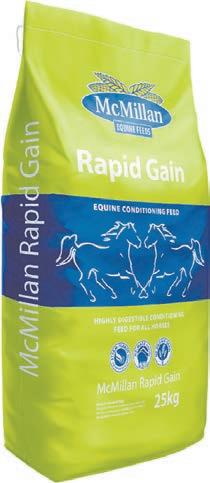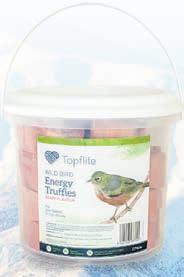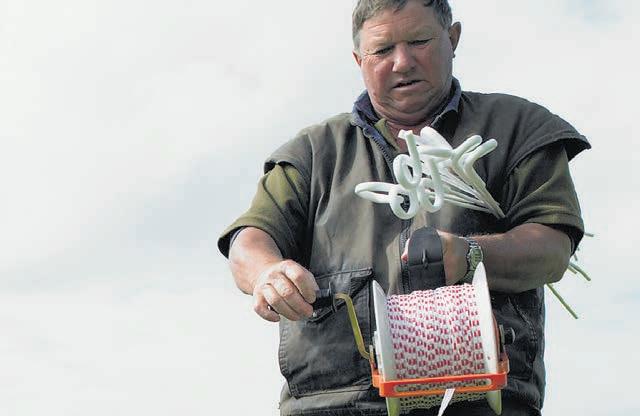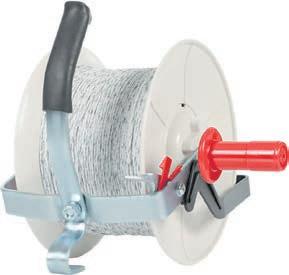







Richard
Rennie TECHNOLOGY CommuniciationsCHORUS has acknowledged it has a job ahead to win the hearts and minds of rural New Zealanders as it moves to switch off the country’s copper telephone network.
The network provider has long signalled its plans to have the copper voice and broadband network off the air by the end of 2026 in areas where ultrafast broadband alternatives are offered, and completely gone by 2033.
Rising repair costs, lack of spare parts and rapid advances in alternative technologies have all meant the legacy system that has existed for much of the NZ phone network’s life is coming to an end.
The move has already rung alarm bells in some rural areas.
Federated Farmers board member Mark Hooper pointed to a recent Feds survey that highlighted 52% of respondents still have a landline and 17% still rely on the copper network for their internet connection. He raised the loss of copper as another threat to rural connectivity, citing uncertainty over it being replaced in all areas with fibre.
Anna Mitchell, Chorus’s general manager for its fibre frontier team, said the installation of a
national copper network had been something of a nation-building effort, but is one whose time has come.
“We are now at a point where what people need is not a voice line, but the ability to use the internet, over which voice can be one use.”
She acknowledged, however, that there is a growing need for Chorus to better educate rural customers about what their options are to tap into the broadband alternatives now available.
“We do not want people to think they are losing something they have valued.
“We have not yet found a site that cannot be served by an alternative technology. Often this will include the new low orbit satellite technology.”
She said wireless broadband suppliers have also done a good job employing their local knowledge to hook rural users into broadband connectivity.
Ideally fibre optic is the gold standard for connectivity, and Mitchell confirmed Chorus’s efforts to push this out further into rural areas.
“We think there is an opportunity to take fibre further.
Back in February we announced a Chorus-funded rollout of another 10,000 homes and businesses for rural or satellite communities around NZ.
Continued page 3

Eighteen young stock handlers took part in the recent World Angus Forum Selection event at Timperlea Angus in North Canterbury, including Libby Stewart of Whenuapapa Angus.

Strong profits for ANZCO put daylight between it and major processors.
NEWS 4

Photo: Ben Doubleday Photography
After 18 months chasing snow in Canada, Kristina Illston, second from left, found herself longing for the rolling green hills of Taihape. SHEEP & BEEF 19-24
Dairy Woman of the Year stresses value of farmer, veterinarian bonds.
PEOPLE 7
Facebook page that’s part of the fabric of NZ farming marks first 10 years.
PEOPLE 16
in
Bryan Gibson | 06 323 1519
Managing Editor bryan.gibson@agrihq.co.nz
Craig Page | 03 470 2469 Deputy Editor craig.page@agrihq.co.nz
Claire Robertson
Sub-Editor claire.robertson@agrihq.co.nz
Neal Wallace | 03 474 9240
Journalist neal.wallace@agrihq.co.nz
Gerald Piddock | 027 486 8346
Journalist gerald.piddock@agrihq.co.nz
Annette Scott | 021 908 400 Journalist annette.scott@agrihq.co.nz
Hugh Stringleman | 09 432 8594
Journalist hugh.stringleman@agrihq.co.nz
Richard Rennie | 027 475 4256
Journalist richard.rennie@agrihq.co.nz
Nigel Stirling | 021 136 5570
Journalist nigel.g.stirling@gmail.com
Lana Kieselbach | 027 739 4295 production@agrihq.co.nz
ADVERTISING MATERIAL
Supply to: adcopy@agrihq.co.nz
SUBSCRIPTIONS
0800 85 25 80 subs@agrihq.co.nz
PRINTER
Andy Whitson | 027 626 2269
Sales & Marketing Manager
andy.whitson@agrihq.co.nz
Andrew Fraser | 027 706 7877
Auckland/Northland Partnership Manager andrew.fraser@agrihq.co.nz
Jody Anderson | 027 474 6094
Waikato/Bay of Plenty Partnership Manager jody.anderson@agrihq.co.nz
Palak Arora | 027 474 6095
Lower North Island Partnership Manager palak.arora@agrihq.co.nz
Omid Rafyee | 027 474 6091
South Island Partnership Manager omid.rafyee@agrihq.co.nz
Julie Gibson | 06 323 0765
Marketplace Partnership Manager classifieds@agrihq.co.nz
Andrea Mansfield | 027 602 4925 National Livestock Manager livestock@agrihq.co.nz
Real Estate | 0800 85 25 80 realestate@agrihq.co.nz
Word Only Advertising | 0800 85 25 80 Marketplace wordads@agrihq.co.nz
Dean and Cushla Williamson Phone: 027 323 9407 dean.williamson@agrihq.co.nz cushla.williamson@agrihq.co.nz
Farmers Weekly is Published by AgriHQ PO Box 529, Feilding 4740, New Zealand Phone: 0800 85 25 80 Website: www.farmersweekly.co.nz
ISSN 2463-6002 (Print) ISSN 2463-6010 (Online)

We are leading the world. We’re right at the top of the chain there on sustainable farming.
Ruth Leary, AgriZero1-11
12-15
16
17
19-24
29-32
33-35
35-41

CUTTING BACK: MPI directorgeneral Ray Smith has released figures showing that his ministry has this financial year found $221 million in savings and has 87 fewer employees than a year earlier. STORY P9
The national sheep flock fell 3% in the year ended June 2023, mainly due to a reduction in the area of grassland, figures released by Stats NZ show.
There were 24.4 million sheep in New Zealand, down 770,000 on the previous year. In the same period, total beef cattle numbers fell by 4% (167,000) to 3.7 million and dairy cattle by 1% (45,000) to 5.9 million.
Modest global milk supply has prompted Rabobank to forecast an $8.40 kg/ MS milk price for the 2024-2025 season.
Milk production from the main global export regions will expand only slightly in the third quarter of this year before gaining some momentum towards the end of the year, it predicts. Low profitability over the past 12 months has led to a decrease in dairy herds in key regions like the United States and South America.
After a long and successful innings at Skellerup, David Mair has been appointed chief executive of Sanford, the listed fishing company.
Mair resigned as CEO at Skellerup earlier this year after 14 years at the helm. He has been a director at Sanford since November 2022 and is now an executive director, effective from May 1.
A Canterbury father and son have been fined $47,500 for their failure to register the movements of hundreds of cattle with National Animal Identification and Tracing. Keith Bruce Townshend, 69, and Joel Charles Townshend, 39, were sentenced on May 6 under the NAIT Act in the Ashburton District Court. Keith Townshend runs farms in the Ashburton and Banks Peninsula areas and was fined $20,000 on two charges while Joel Townshend, who runs farms in coastal Wakanui, was fined $27,500 on three charges.


Continued from page 1
“We are really eager to take fibre further but unfortunately the economics of it make it quite challenging, so we are constantly in discussions with government about that opportunity.”
She said as demands on farmers to track and record data grow, greater broadband connectivity is an essential foundation to enable them to achieve that.
She pointed to a joint NZIERChorus report that found there was an additional $16.5 billion of income over the next 10 years to be earned if rural connectivity receives a boost to fibre-capable levels.
Cyclone Gabrielle also did much to raise the importance of connectivity, keeping it well in the government and public mind, even more so than electricity connectivity.
However, the evolution of multiple types of technology to access broadband internet also means it has become increasingly difficult to flatten charges and cross-subsidise across the ruralurban boundaries.
“The economic reality is that a lower population density and increased distance mean the options will be either rural users have to pay more, or the government contributes to deliver more equitable access.
“This is a real reason to have a proper debate about it, it is a very real rural community issue.”

can be connected with alternatives to the copper network, with fibre optics offering the gold standard, but at a cost, says its GM for Fibre Frontier Anna Mitchell.
 Richard Rennie TECHNOLOGY Communication
Richard Rennie TECHNOLOGY Communication
RURAL New Zealanders will be the first in the world to access a new satellite-based internet system scheduled for launch in the next 12 months and due to shake up satellite services here.
Amazon used the Rural Connectivity Symposium in Rotorua to announce Project Kuiper, the working title for what has previously been a top-secret project aimed to go head to head in a space-based internet race against Elon Musk’s Starlink.
The US$10 billion ($16.6bn) project aims to get 3200 low earth orbit satellites spread across the globe’s skies to increase access to the internet, with a focus on developing nations.
Amazon’s head of public policy, Alasdair Grant, said the giant United States company intends to launch clusters of satellites from the outer edges of the map and work inwards, putting NZ firmly in the early launch window.
“Starting from 56deg north and south we work inwards in five
different phases, and this means countries in the 39deg to 56deg range will be first to receive global coverage.”
The company has secured 80 launch slots on rockets for the massive deployment and built a 20,500 square metre factory in Seattle capable of building the microwave-sized satellites at the rate of about five a day.
Grant said a key aim for Amazon is to ensure the service will be affordable to the millions currently finding it difficult to access the internet. This has required significant R&D to develop a lowcost user terminal that hooks into the satellite network.
He said the estimated cost for a domestic user’s terminal is about US$400.
“The first prototypes were tested last October with 100% success rate and we intend to be launching quite soon.” He could not be more specific on exact launch dates at this point.
In NZ the Starlink system is claiming about 14% of the rural internet market, a level of penetration Grant said had surprised Amazon.
“It is interesting to see how

quick the uptake has been and confirms we have made the right decision to enter the market.
We believe the market is big enough for multiple players in the constellation business.”
At present Starlink’s standard terminals are retailing at Noel Leeming for $599, while subscription costs vary but can be from $160 to $426 a month.
Queried about the risk of adding to a growing mass of space junk circling Earth, Grant said that had been at the forefront of Amazon’s satellite design.
“The satellites do degrade quicker than geo-stationary
SPACED: Amazon’s Kuiper project intends to boost internet satellite capability by 3200 in the coming year, starting from the bottom and top of the world.
satellites because they pass through extremes of temperature. But being only 600km high means it is possible for them to burn up in the atmosphere.”
Life expectancy is estimated to be about six years for the satellites.
One criticism of satellite internet is the effect of “rain fade” in heavy wet weather, but Grant maintained this was less than what can be experienced during wet weather on copper wire-based networks. He pointed to Telstra Australia, which is decommissioning its copper network, often in favour of using satellite-based systems in its place.
 Wallace TECHNOLOGY Communication
Wallace TECHNOLOGY Communication
RURAL communities will become increasingly isolated with news the copper-based communications network is being removed, says a farming leader.
This follows remote roads and bridges not being maintained and NZ Post ceasing Saturday rural delivery of newspapers and parcels.
Federated Farmers board member Mark Hooper said isolation is becoming a growing problem for some rural communities.
“You take post, connectivity and roading, and isolation is increasingly becoming a problem,” said Hooper. He appreciates the copper wire


network is becoming obsolete and needs replacing, but he wants an assurance it will be replaced by an affordable alternative communications network.
“In an ideal world, fibre will be installed out to farms but there is no certainty that will happen.”
A recent survey by the Federation found 53% of farmers still have a landline, down 27% on a similar 2019 survey, which was due to poor mobile coverage and unreliable electricity services.
The survey also revealed 17% of respondents rely on copper lines for their internet due to unreliable alternatives or they are waiting for connection to the government’s Rural Connectivity Programme.
Hooper acknowledged postal services are expensive and mail
Dose all dogs with Praziquantel at least 48 hours before arriving at
volumes are falling but he fears an imminent review of the deed of understanding between NZ Post and the government could see major changes.
A statement from NZ Post confirmed the deed, which sets out obligations for mail services and delivery including minimum delivery frequencies, will be reviewed this year. It said any changes will be publicly communicated.
Last month NZ Post announced that from the end of June it will cease its Saturday parcel and newspaper delivery service to rural areas.
NZ Post chief operating officer Brendon Main said mail is not affected as it is not delivered on Saturdays.
“We deliver very low volumes of items on these days, and it costs
us more to deliver on Saturdays than we earn from the products we deliver.”
It will also affect rural customers who are PO Box holders and currently receive deliveries through the NZ Post Box Lobby service on Saturdays.
“We acknowledge the affect that ceasing Saturday deliveries may have on Kiwis who live at a rural address.”
Hooper said roads and bridges around the country are not being repaired or maintained as expected, adding to farmer isolation.
A sealed road in east Taranaki damaged by logging trucks is being allowed to revert to gravel while bridges damaged during storms last year have not been – and in one case may not be – repaired or replaced.






ANZCO Foods has reported a strong profit for the 2023 financial year, putting some distance between itself and major meat companies that have reported large losses.
After what chief executive Peter Conley described as an exceptional 2022 for everyone in the meat industry, ANZCO’s revenue dropped marginally to $1.83 billion and its net profit before tax was cut in half to $60.9 million.
That compares with a pre-tax loss by Alliance Group of $98m and for Silver Fern Farms of $36m.
For both industry leaders the reversals from FY2022 to FY2023 were over $200m each.
Conley said ANZCO’s relentless attention to core business activities and strategies and growing returns from strategic investments were keys to success.
While profit was down from the record $147.7m in FY2022, it was still the third-best result in ANZCO’s 40-year history.
Indeed, the past three years in a group have been the best three in the company’s history, he said.
“FY23 was, however, an exceptionally challenging year.
“FY22 saw everything go up; FY23 saw everything go down.
“We had to manage all the volatility and rising costs, while coping with the biggest event of the year – depopulation, cleaning and restocking of the Five Star Feedlot because of Mycoplasma bovis.”
Conley attributed the good result to clarity with the business model, focus on efficiency, execution of the strategy, the strong support of sole shareholder Itoham Yonekyu Holdings, and good management of the supply chain.
FY22 saw everything go up; FY23 saw everything go down.
Peter Conley ANZCO
Itoham had invested in management technology and computer systems for very tight supply chain control, derisking the exposure of large inventories in volatile trading conditions.
The value-add products had strongly contributed, such as beef patties for McDonald’s, beef jerky production and the Angel Bay range of ready-to-heat products at retail and foodservice levels.
ANZCO also produces a range of healthcare products from biotissues, like wound dressings, heart valve replacements and blood serum.
In total, 21% of revenue through
FY23 came from New Zealand sales, Conley said.
ANZCO had a greater proportion of its export revenue from Japan than other NZ meat companies, enabling it to take products right through to retail.
“Otherwise, we sell to a mix of countries and markets very similar to all NZ and Australian meat exporters.”
In FY23 an office in China was opened, to join other offshore offices in Japan, Australia, North America, the United Kingdom and Europe.
“Our company can rely, however, on weekly consignments of finished cattle from its own feedlot, which makes us unique in NZ.”
Months of planning and consultation with the Ministry for Primary Industries went into the Five Star Beef depopulation and clean-up, he said.
All cattle were slaughtered by the end of 2022 and the MPI then had two months of cleaning time.
It took three to four months to bring cattle numbers back to full capacity and begin processing again.
“That meant our high-value niche products were out of the market for around six months.
“It was a considerable impact on our staff, suppliers and customers, who have now returned and supported us throughout, for which we are very grateful.”
The MPI’s M bovis fund covered

the extraordinary costs of the whole exercise.
However, the restocking cost did show up as one of three reasons why an operating cash deficit of $42m was reported compared with plus $133.6m in FY22.
The other two reasons were a large forward purchase of valueadd packaging and a big tax bill following the FY22 record profit.
Conley was asked for a detailed assessment of the lamb outlook, where so many NZ sheep and beef farmers are hurting right now.
He said demand from the higher returning markets like the United States, UK and Europe is starting to pick up and that the worst of the price downturn is over.
Post-covid markets rebounded in
2022 when consumers started to travel and eat out again.
But China lagged behind because the extended lockdowns and property downturns impacted personal wealth.
Consumers have been slow to resume discretionary spending on higher value foods.
Instead, they rebuilt their savings before venturing out again.
“I think we all underestimated the frugality of the Chinese and the size of that market is hanging over all our sheepmeat returns.”
Carcases are broken into a hundred different cuts and products and historically China has been a strong market for many of the lower-end ones.
“As China comes back, lamb will improve.”
 Hugh Stringleman MARKETS Dairy
Hugh Stringleman MARKETS Dairy
AFTER going backwards in March, the Global Dairy Trade market has recovered its momentum and appears likely to end the 2024 New Zealand dairy season on a high note.
In the latest auction whole milk powder rose 2.4% and cheddar
6%, contributing to the GDT index rise of 1.8%. Anhydrous milk fat prices are now their highest in the 15-year history of the GDT, reaching $US7124/tonne.
They have increased by 60% over the past year.
At a whisker under $6600, butter prices are also close to the record
$7000 reached in mid-2022.
In the past six months the GDT price index has risen 12%,
overcoming that 5% fall in March. Over the whole season the market movement for reference products has been positive by 10%, which reinforces the current farmgate milk price predictions of $8/kg milksolids.
While that is not the $9-plus payouts of the 2023 season, it is nonetheless a good, welcome outcome to an up-and-down 12 months.
You may think that replacing your original tyres with the same brand or a cheaper brand will save you money. In fact, it may end up costing you far more because you may need to replace your tyres more often.
For example, the original equipment tyre on the latest Hilux has a tread depth
The Fonterra forecast opened last May at $8 mid-point and dropped to $6.75 in late August after WMP prices dropped 10% in one auction.
A not-so-steady recovery since then has seen the GDT index rise a total of 30% from the trough until now, near the end of the season.
The latest confidence in the market won’t do much to influence the milk price in the season just
ending, but it will inject confidence into the first 2025 forecast, due out at the end of May.
“We continue to think farmers can hope for a milk price in the top half of Fonterra’s guidance range [$7.50-$8.10] this year,” ASB senior economist Chris Tennett-Brown said. “Although it’s very early days for predicting next season, we remain comfortable with our $8.35 forecast for 2024/25.”








ILVER Fern Farms
SLtd would have been profitable last year but for a shortage of meat workers and the disruption and more than $30 million in costs incurred from Cyclone Garbielle.
The company’s chief executive, Dan Boulton, told last week’s Silver Fern Farms Co-op annual meeting that changes in the treatment of software tax also affected its bottom line.
For the 2023 financial year SFF Ltd, which runs the processing the marketing functions, reported a $24.4m after tax loss, and SFF Coop, which owns half of SFF Ltd, a $10.75m loss.
Its Pacific and Dargaville plants were flooded by the cyclone, and Boulton said insurers have so far agreed to cover $23m of those costs.
Four months into the new financial year, Boulton said, SFF Ltd is trading profitably but factors such as an early kill, a flat supply peak and unknown spring conditions for lambing could still have an impact.
The financial pressures affecting sheep and beef farmers from low product prices and high costs were
top of mind at what was a very subdued meeting in Dunedin.
Boulton, who three months ago replaced Simon Limmer as chief executive, said SFF’s plate to pasture strategy and using New Zealand’s environmentally friendly production systems, would lead the recovery of red meat prices and provide some insulation against future commodity cycles.
“Doing what we did yesterday is not enough to take us where we need to be tomorrow,” Boulton said.
He said the strategy has attracted and continues to attract high-worth customers prepared to pay premium prices for meat produced in a way that aligns with their values.
Boulton acknowledged returns to farmers need to increase and quickly, and his challenge is to leverage the strategy into higher values for farmers.
In response to a question, Boulton said about 12% of company sales are value add.
Chair Rob Hewett said the term “value add” has taken on a “halo effect” as consumers increasingly seek and pay more for SFF products other than packed product, because of the verifiably low environment production footprint.
Boulton said NZ cannot ignore

RISKS: CEO Dan Boulton says SFF Ltd is trading profitably four months into the financial year, but factors such as an early kill, a flat supply peak and unknown spring conditions for lambing could still have an impact.
global concerns about greenhouse gas emissions and environmental impact.
He said 80% of NZ exports go to countries that have mandatory or proposed disclosure on greenhouse gases emissions generated in the production of goods.
In addition, new and existing customers are questioning the greenhouse gas footprint of goods and services they buy.
“A sustainability focus isn’t just about attracting new product opportunities,” he said.
SFF will announce its Scope 3 emission targets, those generated from suppliers, later this year.
Questioned about the success of Net Carbon Zero beef, which was launched in New York in 2022, Boulton said scaling up has taken some time but the product’s profile is growing.
He said loyalty programmes for suppliers are also growing, with premium payments to beef suppliers last year increasing 14% and lamb 5%.
Doing what we did yesterday is not enough to take us where we need to be tomorrow.
Dan Boulton Silver Fern FarmsSFF last year paid $1.4m in premiums to qualifying suppliers who were part of Farm Assurance Programme plus (FAP+), with payments so far this year that are ahead of last.
Boulton said SFF’s balance sheet remains strong and the company is carefully managing costs, finding $80m in savings and cost avoidance despite a 50% increase in energy and 20% hike in insurance costs.
It is still prepared to invest where payback is quickest.
Last year capital expenditure was $106.8m, of which $70m was in its processing network.
“We are looking for 1% gains across the business and collectively, if you get lots of 1% gains, it has a big impact on the bottom line.”

IN HIS 16 years as a director of Silver Fern Farms, Rob Hewett served with three chairs, 25 directors and four chief executives.
Hewett, a South Otago farmer, retired at what was his last annual meeting last week, after 16 years on the board of which 10 were as chair.
He is replaced by Anna Nelson,
a farmer from Aria, Waikato, but will remain an appointed director for the transition of Dan Boulton, who has replaced Simon Limmer as chief executive.
Reflecting on his career, Hewett said he was approached in 2007 by former chair Robbie Burnside to join the board and told that such an opportunity may not appear again.
What followed was a varied career that traversed the highs and lows of business.

He saw SFF saved from the edge of financial collapse when it was recapitalised by Shanghai Maling, the closure of eight plants and businesses, but also a doubling in revenue, the business rebranded and the launch of its market-led plate to pasture strategy.
He told the meeting he was constantly focused on the daily challenges of livestock farmers and SFF’s role in addressing those challenges.
The current economic difficulties
will pass and benefits will flow from SFF’s strategy, he said.
“It is absolutely the right strategy and we will absolutely not deviate from it.”
He urged farmers not to fear addressing greenhouse gas emissions, saying New Zealand’s pasture-based farming systems gives it an advantage.
“We should not be scared of these issues, we should face into them and embrace these challenges and the opportunity it
brings us as farmers and NZ as a country.”
An emotional Hewett thanked his fellow board members, staff, farmers and family for supporting his governance career.
“It’s been a blast. If I had to do it all again, I wouldn’t change a thing.”
Four candidates stood for election for two positions on the board. Adrian Ball from Waikato and Gabrielle Thompson from Mid Canterbury were elected.








PERFECT PARTNER














THE bond between veterinarians and farmers is a unique, understated relationship that is critical to the success of a farming business.
It goes beyond just caring for sick animals and is something this year’s Fonterra Dairy Woman of the Year, Katrina Roberts, hopes is treated with greater importance.
Based in Waikato, Roberts is a herd health veterinarian for Anexa Veterinary Services.
For the past 22 years she has provided farm consultancy and has been involved in the redevelopment of many DairyNZ programmes, including InCalf, FeedRight, and body condition score accreditation.
Roberts and other vets are sounding boards, at times consolers and advisers on the constant stream of new information that farmers get bombarded with daily. Winning this award showcases that relationship, she said.
“I don’t think it gets talked about and I feel really privileged to be in this position to be able to say, ‘Look at what we can do.’”
Vets and rural advisers sit at the coalface of helping farmers deal with new regulations and economic and animal health issues.
It provides immense satisfaction to Roberts when that relationship leads to better outcomes on the farm. This is what has driven her over the course of her career.
It’s also personal. Roberts’ farmer-clients know how she likes her coffee, and she knows the names of their children. It extends into the local community where

It’s really special to be able to say, ‘Look what we can bring to the farm team.’
Katrina Roberts Fonterra Dairy Woman of the Year
neighbours are clients and see each other when dropping their children off at school.
That relationship personifies what rural communities are – the connectivity where everyone helps each other out, she said.
“The strength of that relationship can lead to amazing changes on farm and it’s really rewarding for us as vets. I don’t think that gets heard.
“It’s really special to be able to say, ‘Look what we can bring to the farm team.’
“It’s often the vet or the farm
adviser sitting around the table with the farmer trying to figure it out. ‘This has been thrown at us, how are we going to move forward?’”
This role is the reality of working in the modern rural sector.
Australia-born Roberts studied for her veterinarian qualification in Melbourne. While working towards her degree, she worked alongside Jock MacMillian, who suggested that she head to New Zealand to do practical work.
One of the people she worked was Scott McDougall, who established the research centre of the Animal Health Centre (now Anexa Animal Health) and now heads Cognosco, Anexa’s research service.
That evolved into a full-time job as a clinician-researcher and Roberts then went on to complete a Master’s in epidemiology at Massey University.
Over the past 22 years Roberts
has worn multiple hats at Anexa, including collaborating with industry organisations including DairyNZ as well as speaking at Smaller Milk and Supply Herd group events.
Around 2011, Roberts started training with farm consultancy company Headlands after realising that herd health issues were often linked to farm system issues.
Often, one could not be improved without changing the other and it meant discussing issues that fell outside what was traditionally a veterinarian’s remit.
“I realised I needed to be around the table talking about the finances and the supplements being bought in and the grass and feed budgets.
“It was a logical progression because I couldn’t help my farmers anymore.”
Roberts quickly realised she could have a much bigger impact on farms by helping farmers with larger decisions.
“It’s super rewarding, moving into the farm consultancy space.”
Getting into the consultancy space also coincided with her decision to get more of a work-life balance on the lifestyle block she lives on with husband Adrian and her three daughters. Her eldest was born just before she started consultancy training.
The past few months since she was named a finalist have opened her eyes to the work the Dairy Women’s Network (DWN) does and the information it gets out to its members.
“They are another group that puts out webinars and conferences and make connections and help people tap into information as required.”
The annual conference, this year in New Plymouth, was Roberts’ first and she said she was blown
away by its positive atmosphere.
“It brought women together to talk about what’s possible. The whole conference was about ‘What can we do?’
“I definitely think there’s space for the vet profession to be more closely involved with the DWN because I think there’s a lot of common ground there.”
The award includes a scholarship to be part of the Kellogg Rural Leadership Programme. Roberts said she has a few ideas for what to base that programme on but has yet to finalise it.
She said there are a lot of people who have supported her over the years to achieve her goals and she does not believe she would have won Dairy Woman of the Year without them.
Neither Katrina nor Walesborn Adrian have family in New Zealand.
“Our friends are our whanau. They are our support. I’ve also had a lot of mentors on the way within Anexa.”
She is also heavily involved in the community, volunteering with Cambridge Riding for the Disabled and an active member of the Walton School Board of Trustees and netball coaching, and Matamata Pony Club.
Roberts is hugely grateful to Fonterra and the Dairy Women’s Network for the award.
“There are so many amazing women in the dairy sector. Everyone’s working so hard and so positive and contributing to their community and I definitely feel pretty humbled being selected as I don’t feel any different to anyone else.”
MORE:
Listen to an interview with Katrina Roberts on Farmers Weekly In Focus, wherever you find your podcasts.
encompass DWN values.
EASTERN Bay of Plenty dairy farmer Rebecca O’Brien has been named Dairy Women’s Network Regional Leader of the Year.
O’Brien’s award showcases inspirational women who demonstrate excellence at grassroots level, leadership in their local community, and who
The award was announced at a gala dinner at the DWN 2024 Enhance, Elevate, Evolve Conference, held in New Plymouth.
“Rebecca illustrated all of these values, passionate for communities, and true leadership,” DWN CEO Jules Benton said.
“This year’s finalists were a particularly inspiring group –Rebecca, Leilani Lobb and Laura
You Matter, Let ’s Natter
West are all incredible leaders in their regions.
“Choosing a single winner for the award was a difficult task but Rebecca absolutely blew us away with her tenacity and resilience, and her embracing, collaborative approach to everything she does.”
O’Brien started her career in tourism before moving into sharemilking, now managing a 1000-strong herd on two dairy farms in Galatea.
It was the move to this remote area that led O’Brien to push herself out of her comfort zone and connect with her community, ultimately taking up leadership opportunities and breaking down barriers.
In addition to dairy farming, she mentors staff who are training with Primary ITO, volunteers in her local community, and is involved in the Dairy NZ Awards.
Benton, who was also one of the award’s judges, said O’Brien was
instrumental in the growth of the Eastern Bay of Plenty chapter of DWN.
“She embodies DWN’s value of seizing opportunities and has improved the lives of those in the network and her community.
“She has an innate ability to influence people, encourage them to take opportunities, and make a difference.
“She is so well deserving of the Regional Leader of the Year award.”



 Sam Whitelock
Sam Whitelock


 Scott PEOPLE Health
Scott PEOPLE Health
WHEN it comes to suicide, there is no price on making a difference to people’s lives and just how to do that is the focus of Agri Connect, the rural professionals’ seminar rolling out across New Zealand.
The mental health and wellbeing seminar is tailored to giving frontline agents – the rural professionals with whom farmers regularly speak – the tools to offer help.
Run under the umbrella of the “lean on a gate” Whatever with Wiggy charitable trust, Agri Connect is aimed at communities connecting to save lives.
Craig (Wiggy) Wiggins said he has always believed that connecting with friends and community is key to helping with mental health.
Wiggy’s message aims to rebuild community spirit and generate a nationwide connection across rural sectors.
In September 2021, after losing two friends to suicide, he decided to push his message “that we all need to take five minutes and check on each other, just like we used to at saleyards and other community events”.

“It’s a straightforward message aimed at urging people to stay connected and raising mental health awareness.
“Communities are resourceful, as we see all the time. It’s about connection, we have lost the art of connecting.
“We know that just a quick chat
can often make a huge difference.”
While the campaign has a lighthearted vibe, the slogan has a serious undertone.
Speaking at the Agri Connect seminar in Ashburton, suicide prevention officer Pup Chamberlain urged rural service professionals to have the mental
Win a one-of-a-kind cashmere blanket for a
health conversation with the farmers they are connecting with.
“A lot of farmers are going around with a ticking time bomb and they don’t realise it.
A lot of farmers are going around with a ticking time bomb and they don’t realise it.
Pup Chamberlain Suicide prevention officer
“Farmers sleep in their workplace, they operate in a high level of intensity all the time, they have always got that reminder going on 24-7, that’s why getting off the farm is so very important, mentally and physically getting a break.
“Humans are herd animals we need each other; we need our tribe for caring.
“If I come in limping you will ask what’s wrong; if someone doesn’t seem to be their usual self, you are too scared to ask – how hard is it to say ‘I can see you are hurting’?
“Research tells us that 50% of our population think about suicide at some stage in their life so if a person is down there’s a 50-50 chance they are thinking about dying.
“In the past two weeks I have gone along to three doctors with


young blokes because someone made a referral.
“Please, have the mental health conversation, have time to listen, listen and listen some more.”
Lack of succession planning was highlighted as one of the worst mental health issues with 30% of calls from farmers stemming from succession planning that hasn’t happened or been poorly planned and “tipped over”.
Forsyth Barr adviser Mark Grenside said succession is a bomb waiting to go off in most families.
“A lot of farming families are going to need a lot of support in that respect.
“Our duty of care in professionalism is to do our job really well and give people the confidence they need to speak out,” Grenside said.
Mental health advocate and former Māori All Black Slade McFarland has been on the mental wellbeing journey since finding himself on the “pile of players who have been there, come and gone” after he retired from rugby.
“I have had a therapist for 15 years. I call her my incinerator; I take her my rubbish bag full and she empties it every week.
“I know farmers tend to isolate themselves. Problems will only be heard if we are brave enough to share the braveness within ourselves, because we are men.”


We’ve got one 100% New Zealand Cashmere blanket for one lucky follower to give to mum.
Visit Farmers Weekly NZ on Facebook/Instagram to enter.
 Neal Wallace NEWS Regulation
Neal Wallace NEWS Regulation
THE number of staff employed by the Ministry for the Environment rose 39% in the three and a half years to December last year, including an additional 58 since June.
A Ministry for the Environment (MfE) spokesperson said the increase from 648 full time equivalent staff from June 30 2021 to 1068 as at December 31 last year was due to substantial programmes that included reforming the Resource Management Act and dealing with climate change, freshwater and waste policy.
“Much of this funding was timelimited and due to peak this year.”
These figures represent permanent staff as well as staff on fixed-term contracts, and from July 1 2020 to June 30 2023, 35.2% of appointments were employed on fixed-term contracts.
The Ministry for Primary Industries (MPI) has this financial year found $221 million in savings and has 87 fewer employees than a year earlier.
MPI director-general Ray Smith has released data showing that as of April 30 it employed 3669 full time equivalent staff, compared to 3756 a year earlier.
It had 3539 staff in June 2021-22 and 3450 in June 2020-21.
“As part of our current change process we are proposing a further net reduction of 384 positions, of which around 40% are currently vacant,” he said.
[After the Budget is finalised] we will seek feedback from staff on a proposal to reduce the organisation in size.
Spokesperson Ministry for the Environment
The coalition government requires government departments to find annual savings of 7.5% and has been critical of a 4.1% increase in government employees in the six months from June last year.
Smith said it is meeting those targets through a mix of programme and staff reductions and managing costs such as on contractors and consultants.
“In the 2022-23 financial year, operating expenditure in this area was $57.8m, and we are forecasting this to reduce to $38.2 million in 2023-24.”
The $221m in savings comes from $4m of unspent Jobs for Nature funding, $188m in climate change programme savings requested by the previous government’s Rapid Savings Exercise, and $29m from discontinued industry transformation plans.
Smith said the MPI received more than $1.5 billion in both the 2022 and 2023 budgets.
This was used for programmes such as climate change, eradicating Mycoplasma bovis, Food Safety and Biosecurity systems, establishing services to support farmers, foresters and growers and the recovery following extreme weather events in the North Island.
Smith said management is working through 1500 submissions received on its change proposals and final decisions will be made in mid-May.
An MfE spokesperson said it won’t know how many staff will lose their jobs, or the areas from where those losses will occur,

until the government finalises its budget.
“We will then seek feedback from staff on a proposal to reduce the organisation in size.”
Last October the MfE introduced recruitment controls in anticipation of a reduction in its baseline funding.
Those moves included filling most vacancies internally, requiring executive signoff of any vacancies to be filled and not extending fixed-term contracts for contractors or consultants past June 30 2024.
Last year the MfE launched a review of its organisational structure and operating model, which resulted in the disestablishment of 45 Tier 2 and Tier 3 roles and the creation of 33 new roles.
“Due to recruitment controls put in place leading into the change process as well as natural attrition, remaining affected employees were able to be reassigned and appointed to the new roles.
“No employees were made redundant through this process.”

WHEN it comes to the way deer farmers grow their products, the “pull” from New Zealand’s markets is more important than the “push” of domestic environmental regulation.
That’s the message from Deer Industry NZ executive chair Mandy Bell.
Speaking ahead of the industry’s annual conference in Napier last week, Bell said the deer industry organisation and exporters support a market-led approach from farm to plate.
She noted a lot has happened in the past few years.
“Deer farmers have felt overwhelmed by the speed

and scope of changes around environmental policy, but a significant number of them are well progressed in these areas.
“Consumers of our high value products want to know they’ve been grown to high standards.
“Our markets are seeking and welcoming the fact that our primary industry is leading NZ growers and supporting verification of our products.”
Implementing measures such as a Freshwater Farm Plan or joining the NZ Farm Assurance Programme (NZFAP) may well add to the cost of doing business for farmers, but on the other side of that coin it is also underpinning the value of the products being grown.
“The key to success is being able to assure consumers of NZ venison and velvet products that the standards being used are verifiable and genuine.”
Bell noted more than 80% of NZ’s primary sector exports are going to countries that have mandated climate and environmental, social and governance reporting.
She cited the uptake of ScienceBased Targets for Forest, Land and Agriculture for emissions reduction as an example of the way farmers and food processing companies can collaborate using a set of verifiable targets.
More than 7500 entities worldwide have committed to the Science-Based Targets initiative (SBTi), including 35 in NZ.
As food and supermarket chains align with emissions reduction targets, they will start to select suppliers that can prove their products have the lowest carbon footprint.
One of the NZ companies
committed to SBTi is a major processor and exporter of NZ venison, Silver Fern Farms (SFF).
The SFF chief customer officer responsible for the company’s sales and marketing operation, DINZ board member Dave Courtney, said the company is using SBTi as a framework for credible standards where progress can be demonstrated.
He said the NZFAP programmes are critical tools for suppliers to provide credible science-backed measures of the impact of their production systems.
“NZFAP Plus helps ensure suppliers are meeting existing regulation and are ahead of proposed regulation. It positions suppliers favourably for future programme supply.
It’s better to be responding to the pull of the market than just the push of regulation.
“A number of our venison farms are either working through NZFAP Plus or already certified.”
Retailers, especially those at the high end, are becoming increasingly demanding on behalf of their customers and that flows through to the standards expected of suppliers, Courtney said.
Courtney acknowledged there are consumers who are focused on carbon footprint, biodiversity and water quality.
“We need to build that into our systems to keep moving in the right direction.
“It’s better to be responding to

the pull of the market than just the push of regulation.”
Those market signals are especially relevant when coming from First Light’s United States customers, the company’s general manager venison Matt Gibson said.
“This guides our behaviour in terms of the programmes we subscribe to and what we ask of our farmers.
“We are continually researching what drives buying behaviours.”
For First Light this covers animal welfare, soil and environmental health, and assurances around antibiotics, hormones and GMOs.
Alliance Group is also on board with market-led systems for quality in premium products.
Alliance Group manager for assurance, environment and sustainability Dan Cairns said while price and the quality remain at the forefront of customers’ minds, there is a shift towards an interest in environment and sustainability practices.
“Of particular interest are the greenhouse gas emissions throughout the supply chain, with customers wanting to ensure that they are sourcing food from sustainable producers.”
These discussions are ingrained for United Kingdom customers and
emerging in European Union and North American markets, Cairns said.
More than 170 deer farmers and industry representatives gathered for the deer industry conference in Napier, which covered the state of both the venison and velvet markets.

FORMAL negotiations have been announced to create a Free Trade Agreement between New Zealand and the United Arab Emirates.
The pledge to talk was announced on Monday night by the visiting New Zealand Trade Minister Todd McClay and his UAE counterpart, Dr Thani bin Ahmed Al Zeyoudi.
The agreement will be officially named the Comprehensive Economic Partnership Agreement (CEPA). The details of deal are still to be worked out in negotiations, but are aimed to give New Zealand better access to almost 10 million people in one of the richest countries in the world, made up of seven emirates dominated by Dubai and Abu Dhabi. Trade is already extensive, and works in NZ’s favour. It is a top 20 export destination – in the year to
last September, goods and services exports to the UAE increased 17%, to $1.02 billion. Two-way trade was $1.17bn, and McClay hopes for more.
“We would hope to see tariffs reduced in most of the areas that we are in the export business, which is predominantly around food,” McClay said.

“So, in this market, companies like Fonterra do quite a bit already. We’d like to see significant reductions on the products they put in there, which will make New Zealand food exports more competitive in these markets.
“It will also set out a clear framework of rules that some exporters can rely on.”
McClay could not say how big New Zealand trade to the UAE could grow to, but pointed out that the potential for expanded trade from an FTA is demonstrated by the FTA with China, which experienced two-way trade growth from a few hundred million to $38bn.
McClay said there is no official time frame for the talks, but both sides “want it done quickly”.
The CEPA is for now a sort of consolation prize for the stalled FTA with the Gulf Co-operation Council (GCC).
An agreement with this group, which includes the UAE as well
as rich nations like Saudi Arabia and Kuwait, has languished for a decade and a half, despite almost crossing the finishing line in 2009.
The agreement faltered back then due to political difficulties and a fear that mass imports from NZ might disincentivise efforts to somehow get the desert to bloom with irrigated farms and make those Middle East nations less dependent on food imports.
But this policy has eased more recently, since NZ exports have poured in anyway, reaching $1.9bn in the most recent figures. At the same time, GCC countries sold NZ $2.9bn worth of goods, mainly petroleum products.
At this stage, the two sides have agreed to get together and “kick the tyres”, to quote McClay.
“And so, officials will get together in the coming month or so and have a close-up look at the agreement and then report to their ministers.”
 Neal Wallace NEWS Finances
Neal Wallace NEWS Finances
ACASH handling and availability trial for rural communities is being launched by the Reserve Bank, which says it reflects the reality that rural people still depend on cash.
The RBNZ is seeking interest from towns wanting to trial either local cash depots with automated cash banking facilities that work with all banks, or a security van courier service.
“Retailers and their customers are frustrated by cash banking difficulties, especially in rural New Zealand,” said Ian Woolford, the Reserve Bank’s director of money and cash.
A two-yearly bank survey on cash use and payments preferences released recently confirms a continuing decline in New Zealanders’ use of cash for everyday purposes.
The survey revealed the everyday use of cash fell to 57.2% in 2023, down from 60.4% in 2021 and 95.8% in 2019.
Woolford said those living in rural areas find it harder to access
cash withdrawals and deposits than those living in urban areas.
“Overall, the top reason given by respondents for difficulty accessing cash services was that there was no ATM or bank branch in their area. This reinforces the rationale for the trials,” he said.
The bank has so far received nearly 80 expressions of interest from rural towns, where three systems will be trialled to provide communities with access to cash.
Retailers and their customers are frustrated by cash banking difficulties, especially in rural New Zealand.
Ian Woolford Reserve Bank
The bank is still seeking towns to participate in the trial, but they must have populations between 1000 and 10,000 and to have lost most or all cash banking services.
One system to be trialled is the installation of a local cash depot or a smart ATM that allows cash deposits and withdrawals.
A second option is the
installation of a smart safe, a secure unit that allows the storage of prearranged cash for banking and for retailer cash floats.
The third option is for a regular secure service to deliver and pick up pre-ordered cash for rural retailers.
“New Zealanders still value the option of using cash, and we want to see if better local cash infrastructure, and supporting retailers to readily offer cashouts, will help keep the option available,” Woolford said.
Alongside the trials, he said the bank is working to define a reasonable level of cash access that New Zealanders can expect, and ways to ensure that level of access is met.
To accommodate that, the RBNZ is considering paying rural retailers for allowing customers to withdraw a reasonable amount of cash without requiring an associated purchase of goods.
The trial is being driven by the RBNZ but it is also working with cash service providers such as ATM operators and services, back office cash handlers and entities involved in transporting cash.
Applications to participate close on June 7 with towns shortlisted

CASHED UP: A two-yearly bank survey on cash use and payments preferences confirms a continuing decline in New Zealanders’ use of cash for everyday purposes.
and cash service suppliers finalised by August.
The 18-month trial for qualifying towns begins between September
2024 and February 2025 and will end in early 2026 with results expected in the middle of that year.
THE grape harvest in Marlborough and Martinborough was down 21% this season compared with last season, listed company Foley Wines has reported.
It has the Te Kairanga, Martinborough, Vavasour, Grove Mill and Mt Difficulty brands.
The Foley harvest was 6404 tonnes compared with 8137t in 2022-23, chief executive Mark Turnbull said.
Marlborough and Martinborough experienced disruptive weather
and cooler spring growing conditions resulting in a region-wide reduction in yield.
The lower yields and the warm and dry summer resulted in an earlier harvest than usual.
“Our winemakers are delighted with the quality of the vintage and are looking forward to producing world class wines,” Turnbull said.
In 2023 New Zealand harvested 500,000t of grapes in total. Staff reporter




 Bryan Gibson Managing editor
Bryan Gibson Managing editor
NAPIER played host to the Deer Industry New Zealand conference last week, with the sector enjoying a nice boost in value and demand after the trials of the pandemic.
Executive chair Mandy Bell prefaced the event with a message urging deer farmers to embrace the market-driven pull towards greater sustainability and transparency.
“The key to success is being able to assure consumers of NZ venison and velvet products that the standards being used are verifiable and genuine,” she said.
Key exporters like Silver Fern Farms, Alliance and First Light Foods echoed her view.
Each has seen a change in expectations from customers, especially in the high-end space where venison and velvet operate. The SFF chief customer officer
responsible for the company’s sales and marketing operation, Deer Industry NZ board member Dave Courtney, said there are consumers who are focused on carbon footprint, biodiversity and water quality.
“We need to build that into our systems to keep moving in the right direction. It’s better to be responding to the pull of the market than just the push of regulation.”
Now that our government is taking a breather from the relentless regulation farmers have faced, many critics are questioning the market-driven push for sustainability and traceability.
Many global corporations are incorporating ESG reporting, which shows progress on environmental, social and governance benchmarks.
It is taking a while for some others to get their heads around the fact that money is not the only indicator of success.
Profits are important, of course, but consumers are increasingly shunning those who profit from pollution and exploitation.
Some critics say it’s led by agendadriven corporate culture, rather than actual consumer preference.
Separating parts of distant cultures tells of straw man creation, though.
Spend a day watching United Kingdom television and it’s notable that the vast majority of the advertisements are built around the providence of the product, not just its performance.
The evolution of these concepts doesn’t happen solely in a high-rise boardroom – it’s an ongoing conversation between buyers,
sellers, marketers and all of the data that’s captured.
Businesses spend vast amounts of money and time researching the habits, values and actions of their current and future customers.
There aren’t many successful businesses that ignore the data uncovered in this process.
The truth is that accounting for these externalities makes good businesses sense. The age of profiting at the expense of workers and the environment is coming to an end.
Our primary producers should be excited by this opportunity. Compared to other food exporting nations, our farm systems stand out for their sustainability and for the pay and conditions workers enjoy.
It’s worth noting that it’s not just rich, Western consumers driving this change. In this edition Ellie Copeland outlines the movement in Chinese sentiment.
In the past, international brands have been associated with quality there, but more recently its Chinese brands that enjoy that perception.
She says that with exporters like the European Union working towards clear goals laid out in sustainability strategies, it’s important for NZ to continue moving the dial as well.
This conversation between families, communities, retailers and regulators is happening and it’s getting more intense.
We’d be foolish to close our ears to the chatter.
FOLLOWING on from my letter “Layers are stifling wool” (April 15), and then a plethora of noise in the April 29 issue about the future of wool, I feel compelled to write again.
I’m not sure what rock some of these people live under, but to say that “wool returns barely cover shearing costs” is an understatement. My shearing cost were 15k and my wool returns just under 10k. I know someone whose shearing costs were over 200k and returns under 100k.
And since when was it okay to just cover shearing costs? What about everything else that goes into producing wool!
Sorry everyone, your time is up. You are sourcing a product unethically because we are working for less than nothing.
I just need to pay shearers to get the wool off the sheep, then it’s going straight out the door into a hay baler. Then I can stack it neatly down by the main road where hundreds of tourists go past everyday with a big sign on it saying “Pure NZ wool, unethically sourced”.
My meat company pays me 20c a kilo to belly crutch our lambs, so I do 100 a day before breakfast and that more than covers my shearing costs.
To the people who make a living off our wool (although it’s no longer my problem): if you want a solution, look to the kiwifruit industry back in the 1990s. It wasn’t worth growers picking the fruit so they just left it on the vines. The pack houses that had invested millions found another way to protect their investments by leasing the orchards to guarantee supply.
Finally, to the rousies and pressers who have served our industry with honest hard work, I am sorry but I can no longer afford to prop up the wool industry.
To the people further down the line who have worked hard to do great things with a great product, thank you.
To all the people who have pulled the wool over our eyes, spun a yarn and fleeced our rural communities, shame on you.

WHEN I read the piece in Farmers Weekly last week from Federated Farmers’ Manawatū-Rangitīkei president Ian Strahan, there were parts I could agree with.
Kiwi farmers are working hard to improve the environment, supported by Horizons through programmes like the Sustainable Land Use Initiative and partnerships via groups including the Manawatū River Leaders’ Accord.
Strahan is also right about farmers doing it tough with high inflation, rising interest rates and low commodity prices. I want to thank him and the other Federated Farmers members who spoke to our Long-term Plan hearings recently. Their message came through loud and clear. However, suggesting we are not listening to farmers, or are totally out of touch with our rural communities, misses the mark.
Our staff have been working for the best part of four years to implement the National Policy Statement for Freshwater Management (NPS-FM), a mandate from central government we must deliver on.
That featured multiple rounds of consultation, including targeted
engagement with farmers and industry groups, often on very tight timeframes. Multiple groups have said those deadlines, set by central government, were too tight.
Extending our freshwater One Plan change notification date to 2026/27 should help.
The change of government is bringing changes to policy direction. Horizons is stuck between a rock and a hard place on many of those changes: the rock is the government’s signalled, but not legislated, changes; the hard place is our legal requirement to continue progressing work until laws are changed. Our NPS-FM work fits directly into this difficult place.
Suggesting we are not listening to farmers, or are totally out of touch with our rural communities, misses the mark.
I know the provisional water quality targets were hard for many to see last year. They showed not only the decades of damage done to waterways via a range of inputs, but also the significant amount of work needed to restore their health. It’s a very real situation that is no one person’s fault, but the responsibility of everyone to remedy.
Horizons specifically consulted with rural communities on these provisional targets. The roadshow we ran, going to rural towns and villages, is proof of that.
People from those places, as well as groups like Federated Farmers and catchment collectives, gave their views, which will play a part in formulating the freshwater One Plan change.
The economic and social analysis on the provisional targets is taking longer than we wanted. Every regional council is doing the same work, requiring the same experts, causing delays. We have committed to another rural roadshow when we have this analysis.
Rates is another big issue. Horizons, like most councils, relies on rates to fund the work we do. Bluntly charging rates based on the value of property, regardless of ability to pay, is not a good system. It is, however, the one we must work with.
A 6% rates increase used to be considered large. This year, the national average is more than 15%. At least one council is proposing above 30%. Horizons’ average proposed increase is 12.9%.
I know this is unaffordable for people already struggling to make ends meet. Some have said potentially changing our Uniform Annual General Charges is the
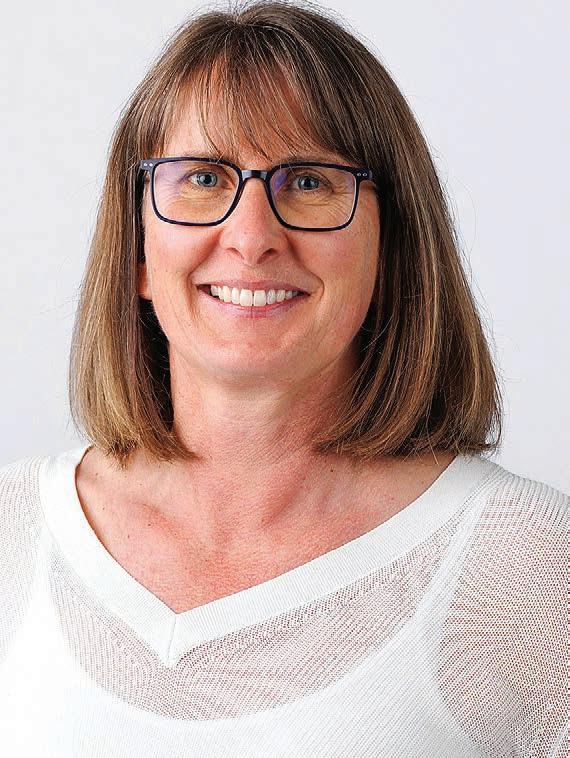
biggest impact on rural rates. But high rates increases across the country are a disaster that has been building for a long time.
Central government’s share of taxes as a percentage of GDP has effectively tripled in 100 years. Rates have remained basically flat.
Despite this, Horizons continues to be legally required by central government to carry out more and more work without any extra funding to help.
Councils have asked central government for help, such as returning the GST paid on rates or regular co-investment in flood protection and climate mitigation assets, but for now we are stuck with the funding model we have.
High inflation and rising insurance costs have hit Horizons too, with the second of those especially significant on river and drainage schemes. Councillors are investigating how we can
LISTENING:
Horizons Regional Council chair Rachel Keedwell takes issue with a Federated Farmers leader’s characterisation of the work the council has done.
minimise those impacts.
With farmland valued highly, I know the impact of rates increases is keenly felt in rural areas. Ruapehu, Tararua and Rangitīkei districts will feel it harder due to property revaluations in the past year.
About one in 25 properties in the region have a proposed rates increase of 30% or more, which jumps to three in 25 properties across Ruapehu, Tararua and Rangitīkei. The impact of revaluations is also outside of our control – another part of the broken rates system we have. My colleagues and I around the council table are listening to all voices, including those of farmers, during the freshwater reform and Long-term Plan processes. We, like you, are working to do our best in uncertain times to deliver the best possible results we can for all.
AS AUTUMN progresses, a dry rural Canterbury is relieved by some much-needed rain and hunters start to gear up as stags roar into action.
With the excitement of the “Roar”, police generally see an increase in unlawful hunting and poaching and we would remind hunters that hunting on land without permission is dangerous, reckless and carries a significant fine or term of imprisonment.
The NZ Police ask landowners to remain vigilant for unlawful hunting activity and call 111 immediately if poaching is suspected.
This year there has been an increase in reports of unlawful hunting, particularly around the Oxford and Mackenzie Basin areas.
Recently, hunter’s vehicles have also been targeted and broken into around North Canterbury, and hunting equipment and an unsecure firearm have been stolen.
If you see this taking place, record details of vehicles and
take photographs of any evidence located.
It is a good idea to keep a record of any hunters with permission to access land and the time/location they have that permission.
Small details like a vehicle behaving suspiciously in an area can assist the police making enquiries into other crime reports in the area.
Reporting information gives the police a greater opportunity to identify offenders and prevent further targeting of rural proper-
ties. North Canterbury rural community members can make reports using the Rural Lookout app, which is proving to be a useful reporting tool for both the community and police.
Police technology capability is always developing and improving our ability to ensure offenders face consequences. For example, we have previously used the results of forensic testing of animal carcases to successfully link an offender with poaching activity.
Recently, a search warrant

was carried out at a taxidermy business, recovering a poached trophy animal that was unlawfully hunted in the Kaikoura area.
Two people are currently facing a range of unlawful hunting and firearms charges in relation to this offending.
A conviction on hunting-related charges can often lead to the revocation of firearms licences and forfeiture of hunting equipment.
Hunters are reminded to abide by the rules and always follow the “seven rules of firearm handling”, including new rules around carriage, transportation and storage of firearms. More information about this can be found on the Firearms Safety Authority website.
Canterbury is seeing offenders easily and frequently using vehicles stolen in one part of Canterbury District to commit offences in another. It is important to have a hard look at your property and habits and identify where you can improve security to prevent your property from being targeted.
This looks like locking doors and vehicles, knowing your neighbours, and having contact details for them.
Other options include installing CCTV, especially around fuel bowsers, entry points and implement sheds. GPS devices are also being regularly used around the country and can be discretely fitted to motorbikes and farm trailers.
The police often get asked by farmers and those living in remote communities when to call 111 or 105 to report crimes and suspicious activity.
The general rule of thumb is if it is happening now, call 111. This could be an unfamiliar vehicle lurking around rural driveways, unknown people on or around your property, or unlawful hunting activity.
Dialling 105 is a reporting option for when the police do not need to be notified immediately. This could be when something is discovered to be stolen, a historic burglary, remains of poaching or stock theft or something suspicious you noticed that day.
The NZ Police wish the rural community a safe and happy hunting season. Remember to report instances of illegal hunting or suspicious activity and take preventative steps to secure your property.
all be

Alan Emerson Semi-retired Wairarapa farmer and businessman: dath.emerson@gmail.com
THERE’S been considerable commentary on rates and the current round of increases.
I’m unaware of any rural rates increases in single figures and some are well into double.
There are two issues, as I see it. The first is the increase in the rates to fund councils and that’s the original problem.
That is exacerbated by the increase in valuations. For example, in Masterton the rates rise from the council is 16.1% but there are many local farmers paying in excess of 30% courtesy of the increase in RVs from Land Information NZ.
Land Information NZ’s website tells me that they average recent sales, which on the surface of it is fine.
The problem is that recent sales have been to take land out of food production for forestry, where purchasers are prepared to pay a premium. That premium has then been translated to RVs, putting their subsequent rates in the fairytale category.
Richard Moore is a highly experienced local rural valuer, farmer and director of Wairarapa Property Consultants.
“It all depends on the land status under the [Emissions Trading Scheme],” he told me. “Land under forestry that was planted pre-1990 is significantly cheaper, between $2000 and $4000 a hectare. That’s because there is no involvement in the ETS.
“Pastural country capable of planting and registration into the ETS was up to $15,000 per hectare but it has since come back to $10,000 ... and we anticipate further softening.
“We have seen very few pastural sales for animal production recently,” Moore said.
The issue is that one local farmer has a land RV of $10,500 per hectare to farm sheep and beef, which I find ridiculous and far removed from reality. Doing a budget, I wouldn’t want to pay
more than $7000 in the current market so an RV of $10,500 is wildly out of touch – 50% out of touch.
I am aware you can appeal against your RV but that requires time and effort. In the current market farmers don’t have much of either.
My suggestion to Land Information NZ would be to do it once and do it right.
The issue isn’t just the valuations but the fact they provide the basis for rates. The higher your value the more rates you pay. When values get into the absurd so do rates. They are, effectively, a tax on production –I’d humbly suggest an unreal tax on production.
This isn’t just a Wairarapa problem but one for the eastern North Island and I can see it spreading further.
Anthea Yule is the meat and wool chair of Hawke’s Bay Federated Farmers and provincial vicepresident. She isn’t happy.
“The rateable value of our farm lifted 54% between August 2019 and August 2022 driven by the carbon frenzy and strong commodity prices,” she told me.
“Hastings District Council has announced a 25% increase from July to cover cyclone costs. They are already $400 million in debt, likely rising to $700m by 2030.
The rateable value of our farm lifted 54% between August 2019 and August 2022 driven by the carbon frenzy and strong commodity prices.
Anthea Yule Hawke’s Bay
“The rural sector is paying more for less. It is paying more with less,” she said.
Hawke’s Bay rural landowners have an additional problem as the regional council has increased rates by 19%. That’s just an average and according to Hawke’s Bay Feds chair Jim Galloway, a farmer in Hastings will suffer an increase of 27% with a Central Hawke’s Bay farmer facing a 24% increase.
Feds policy staff have worked out that since 2015 rates have increased 165% in Hastings, 186% in Central Hawke’s Bay and 197% in Wairoa.
That is unsustainable.
Sheep and beef profits are down 54% this year or 67% since the 2020/21 year. Interest rates are high and input costs through the roof.
Now farmers are hit with a considerable tax increase as I believe that district and regional council rates are as much of a tax as income tax or GST.

VALUATIONS: The problem is, says Alan Emerson, that recent sales have been to forestry, where purchasers are prepared to pay a premium. That premium has then been translated to RVs, putting subsequent rates in the fairy-tale category.
Providing a reduction in income tax while having farmers hit by a massive rates increase doesn’t achieve much. At the end of the day a farmer is worse off.
So at this point farmers are facing a triple whammy. Basic district council rates are up, in some cases heading towards 30%.
That is exacerbated by the increase in RV, meaning a total farm rates bill to the district council can head towards 50%.
Then we have the regional council rates increases, which has me stuffed. The government has indicated infinitely less work for those councils meaning rates should reduce, not increase. I can see absolutely no reason for regional council rates to go up. So we have a system that is broken and needs fixing and now, because if costs keep increasing as they are and incomes keep declining as they have, there can only be one result.

CHINESE consumers have historically been seen as “less sensitive” to sustainability concerns, but there is evidence that the picture is changing.
In China, government direction creates ripple effects through business and society.
We are seeing prioritisation of sustainability, with clear targets for peak emissions by 2030 and carbon neutrality by 2060. Large multinationals, driven by more ambitious global agendas, are also playing a role in educating consumers.
Rapid change is also driven from the bottom up, through savvy and connected consumers. People are strongly influenced by social media, where sustainable ideas are increasingly entering the conversation.
Trust and quality are important to Chinese consumers, and central to sustainability.
We have a head start – New Zealand is seen as a leader in trusted, top quality food.
The 2000s were a turbulent time for food safety in China.
The 2008 milk scandal involving melamine-contaminated infant formula was just one of the many disasters that set food safety and quality as a top priority for both government and consumers.
In a time of food safety concerns, NZ was seen as a clean, safe haven for top-quality and nutritious produce.
The result was that NZ food brands in China had the equivalent of landing on “Pass Go, collect $200”.
On a recent trip to explore the current and future state of sustainable food in China, I spoke with business leaders who noted there is still that trust in the quality of NZ produce. “Tell people it’s from New Zealand, and that’s enough” was a pretty encouraging comment to hear.
Trust in quality is particularly important in sustainability
marketing, where consumers are increasingly jaded and wary of greenwashing. Building trust is not easy, so this is an attribute to cherish and protect.
We need to protect and solidify our position, because the playing field is being levelled
First and foremost, we need to keep doing what we excel at behind the farm gate – producing great food in increasingly sustainable and efficient ways.
It’s hard to be seen in the world of food, and storytelling matters.
But we also must be seen and heard, to reward the outstanding work farmers are doing, and capture the demand and value, because we are facing increased competition from both domestic and international brands in China.
Historically, Western brands were those associated with quality. This has drastically changed –local consumers are increasingly seeing local Chinese brands as premium, trusted and interesting. International brands are increasingly competitive, telling a similar story of clean, safe, premium, nutritious food – like Irish meat brands with their grass-

eating.the.elephant.nz@gmail.com
I’D LIKE to start this column by saying sorry. A retraction if you like. In my previous article on the perils of gender diversity, I mistakenly stated that my father was 84. He is in fact 83. I also stated that he got beaten in an arm wrestle by his 60-year-old female neighbour. Apparently it was, in fact, a draw.
Naturally, I would like to express my apologies to the offended party and confirm that all other statements made in the article were 100% correct, for the most part.
And so on to the main subject: Americans.
I like Americans and recently I met a few more of them. They were from Texas, to be exact, where they drive trucks three times too big and have a habit of losing their guns in the seat pockets.
But Texas is also the land of big business. In my travels there I met a gentlemen named Andrew Volleman. Andrew and his family moved from their home in the Netherlands to Texas in 1993, in search of opportunities to grow
Continued from previous page
fed positioning, or Australian meat brands with a consistent grain-fed story. If European Union producers meet 2030 emissions and environmental targets set out in the Farm to Fork strategy, they will be in an even stronger position to tell this story.
It’s hard to be seen in the world of food, and storytelling matters. We have great individual brands in market and these each have their own role to play. To be chosen amid a sea of competitors, we need to both strengthen these individual brands and tell the same compelling NZ story, again and again across these brands.
This means showing up together as a united front with a clear, consistent and highly emotive provenance brand to build salience and capture value.
This is particularly the case in sustainability messaging. If we can continue to build trust and education through our strong base story, individual brands have less of a job to do to convert consumers.
their dairy business and allow future generations of Vollemans to take their place within it.
Starting with 100 cows, the Vollemans now milk 5000 a day, supplying their own brand of milk in glass bottles across the state.
The glass bottles were important to the Vollemans as they wanted to demonstrate their commitment to sustainability and also stand out in the marketplace. The big sticking point with this was the supermarkets, who were happy to sell the Vollemans’ milk, but not collect their empty bottles.
Ultimately, the Volleman’s Family Farm brand was so strong that the supermarkets gave in to consumer demand and started collecting the Vollemans’ bottles and processing the customers’ $2 deposit. A big turnaround from a previous “hard no”. The Volleman’s brand is now so strong that in 2021 it was appointed the official milk supplier of the Dallas Cowboys.
There were a lot of things I took from the Volleman’s story but two stood out.
The first is that supermarkets can be brought to heel if your brand is strong enough and consumer demand is great enough.
The second is that scale was a strong component of that success. It enabled the Vollemans to access the capital and bring on the marketing muscle necessary to build a highly successful brand.
Moving nearly 12,000km southwest from Texas we find ourselves back in our wee land of milk and honey, New Zealand. Scale and capital are not two things that you readily associate with our fine young country.
They are, in fact, the two things that are badly holding us back. However, looking forward I think that may be about to change.
NZ farmers are continuing to get bigger because they have no choice. We have few strong

The big sticking point with this was the supermarkets, who were happy to sell the Vollemans’ milk, but not collect their empty bottles.
brands so the only way to stay in business is to chase profitability via economies of scale.
But continuing to grow within the context of increasing market and climatic volatility is going to require the support of increasingly large and sophisticated investors.
These investors will see the value in food production investments, especially within a world increasingly focused on food
2019,
security, but these same investors won’t tolerate the poor and lumpy economic returns that the average farmer does. Nor will they accept the terms of trade currently offered by our four major banks.
These investors will start chasing market power like the Vollemans did.
My guess is that they will look to where they can create market power within their various parts of the sector. They may look to form new and stronger co-operatives, or create products instead of commodities, or create brands that are so strong that value is captured by the grower and not the retailer.
They may also drive to create the formation of lending institutions such as Germany’s Rentenbank, which supports the development
with what consumers care about. Its effectiveness has been

of agribusiness through lowinterest loans.
I have no clue what approaches they will eventually employ, but I know for certain that they won’t accept the status quo.
No one wants to see vast tracts of NZ farmland empty of the small towns and communities that were once such an important part of its fabric. Unfortunately, the great land consolidation ship has sailed, and I doubt there’s anything that’s going to turn it back.
But if it’s any comfort, it may ultimately drive the change that is so badly needed by the sector and return the profitability back to those who actually own the means of production.
We just need to hang on until it does.
extensively researched across our export markets.
The connection to sustainability in this story, expressed in a way that speaks to quality, taste and health, provides a base for individual brands to capture value from sustainability credentials. This supports return for the great practices being implemented behind the farm gate.
Importantly, Taste Pure Nature is a campaign that aims to educate consumers around the health and environmental benefits of grassfed meat, which is particularly important in the context of the Chinese market, in which grainfed is more familiar and currently aligned with premium.
Taste Pure Nature needs industry aligned behind it to have impact in such a big and competitive market. In future, maybe the Taste Pure Nature brand could even be leveraged outside of the meat category, to grow its impact.
We need to continue to punch above our weight – not just in what we’re doing, but in how we show up.
Let’s stand together to stand out.
A community Facebook page that became part of the fabric of New Zealand farming is celebrating its first 10 years. Olivia Caldwell reports.
D‘EAR NZ Farming, I understand that you put up profiles of single NZ farmers looking for someone,” 24-year-old bodybuilding dairy farmer Marcella Bakker posted on the community website in its early days.
The post caught 250,000 views and 500 interested Kiwi farming bachelors, though Bakker chucked in her search and left for Australia to pursue a career in real estate. Her 2016 bid for love on the NZ Farming page was a flop, but the NZ Farming Facebook page survived the heat and will celebrate 10 years of its own fame this month.
“This one went pretty nuts because Marcella was looking for a decent bloke. Story made it all the way to the UK,” says NZ Farming’s co-author Duncan Humm.
You’d be forgiven for thinking the social media page started out as a dating site for Kiwi farmers, but the real story is much more sincere.
Humm says his mate Tyler Fifield came up with the idea for the page while he was living alone and feeling isolated.
“Tyler was starting out as a young shepherd in the back of Whanganui somewhere. One night he was feeling quite isolated and for a young guy he wasn’t really well supported in his job,” Humm says. “He saw on Facebook ‘start
page’. He says, ‘Maybe I could start something and get a few yarns going and what not.’”
Humm liked the concept and soon after joined the fold.
A decade on and the page has close to 250,000 followers, 66,000 Instagram followers, a Twitter and Tiktok page, a job search website, monetised merchandise – but no dating page, despite Bakker’s post.
“I can’t remember what our first post was, but it would have been something about what’s happening with the weather or something like that,” Humm says.
In the first year they had 5000 followers and things escalated in 2016 during the Kaikoura earthquakes.
“It exploded then because there was just a heap of people trying to link up with loved ones that they couldn’t get a hold of and people wanting to be connected for volunteer support.
“It was bush telegraph meets modern media in a way.”
They were messages like ‘My second cousin lives up this valley, anyone know how they are?’ We had posts going continuously and people could ask or someone could message in or comment.”
For Humm it was one of the most mentally draining periods of his life, answering constant messages, posts, linking people together and biting off far more than he could chew, while doing his day job deer farming 145 hectares at Mount Somers, mid Canterbury.


“I have tried to figure out what is wrong with me, I think I am quite a selfish person normally ... but if someone asks for help, I just can’t say no to it.
“After Kaikoura I was just like no, it takes a huge toll on you ... next thing you know you are kind of organising airplane loads to an airstrip you’ve never heard of in the back of beyond.”
The page itself raised over $60,000 for volunteer helpers in Kaikoura. It took on a similar role in Cyclone Gabrielle last year in Hawke’s Bay.
Humm describes the NZ Farming concept as “a kind of the fabric of rural New Zealand”.
An accurate summary when you look at the daily posts of hay bale shots, green pastures, sunsets, dogs for sale, cattle musters, Canterbury shorts, Red Bands, baleage moisture content hot tips ... you get the idea.
But with fun and hearty content comes responsibility. Humm believes he handles it with enough sensitivity.
“We try to be positive and constructive primarily, but every now and again you have got to be a little bit careful. If someone needs a bit of a tune-up then so be it.
“The way we see it is we are quite open to having open conversations, whereas a lot of people are quite averse to having challenging conversations.”
In an environment where trust in more formal NZ media channels is at a low, and with media agencies closing down, facing redundancies
and struggling to define themselves against social media that often houses misinformation, Humm insists his page will remain a wide-open forum “for all voices”.
“Part of the secret sauce of what we have endured is I guess we are kind of alright with someone who has an opinion and may be fobbed off as being a bit of a cooker.”
Next thing you know you are kind of organising airplane loads to an airstrip you’ve never heard of in the back of beyond.
Duncan Humm
NZ Farming community page
He says there is “quite an amount” that is culled off before it reaches the public eye, but less so than in mainstream media.
“It’s not free-for-all. Any post that goes up, we’ve got to have a look at it ourselves.
“Sure, some of it may be disagreeable and complete and utter bullshit, but people want to feel heard. Perhaps their industry leaders will shut down fast opinions, so I think you should look at everything as an adult and open mindedly.”
Humm says he has broad shoulders for the criticism from industry leaders, who at times have wanted to see the page shut down. He won’t name them.
“At no point is everyone going to agree and that is what makes
the topics interesting. It is a big contest of ideas. If you have an idea, you put it out there and test it. If half the people tell you you’re an idiot, there’s still a 50% chance you’re not.”
The “business” isn’t putting too much time into strategy for the future; they’ll undoubtedly be winging it for the next decade.
“We’ve got one guy and all he does is dog trial posts and that’s all you see for a while.”
While critics will claim mainstream media has a leftswinging view, Humm has the opposite problem.
“As you can imagine, being rural based you get mostly very conservative views, but there are a few out there who are left leaning.
Auckland is our biggest region in terms of followers so it isn’t all farmers.”
In fact the NZ Farming page was the second most viewed in New Zealand during the 2020 lockdown, second only to Netflix.
They have been approached to be bought out – they’re not interested.
“We said we can monetise the crap out of it from day one and more than likely kill it, or we make sure we keep it pretty low key and as it is.
“We are glad we stayed with that focus.”
“I’m amazed we haven’t been shut down yet despite quite a few at times probably wanting us to bugger off.”
As for Bakker, she did, and hasn’t been seen on the page since.
For generations a group of breeders has been doing painstaking work on a condition that is starting to attract big research funding. Hugh Stringleman reports.
THE Meat Board’s $1 million grant for facial eczema research has been welcomed by a long-standing group of sheep breeders known as Advanced Romney Designer Genetics.
The Meat Board contributed to the Eliminating Facial Eczema Impacts (EFEI) programme, which has a budget of $20.75m over 10 years as a cross-sector partnership between the Ministry for Primary Industries, Dairy NZ, Fonterra, PGG Wrightson, LIC and several other companies.
The FE project aims to provide tools, knowledge and solutions for farmers to combat the disease while also improving productivity in the red meat and dairy sectors.
Advanced Romney Designer Genetics (ARDG), formerly the Auckland Romney Development Group, was founded 56 years ago and has been hugely influential in breeding facial eczema tolerance and worm resistance.
The flocks of the group are spread from Kaipara in the north to Masterton in the south of the North Island.
Retirements and changes of ownership have ushered in new breeders, although the founding Alexander family remain prominent.

The late Rex Alexander formed the ARDG with the help of eight other Romney breeders with the objective of improved production and profitability, but they quickly realised that the annual scourge of facial eczema had to be tackled.
At the time Rex and his wife Marion were farming at Waiuku in South Auckland, a hot spot for the disease.
He recognised the importance of genetic differences between
animals, both sheep and cattle, in their response to the FE challenge in northern regions of the country.
That challenge comes from ingestion of spores of a fungus that grows on pastures in autumn under certain conditions – most often after dry summers followed by warm, wet autumns.
The spores contain a toxin that causes damage to the animal’s liver, which can be clinically expressed on the skin of the face or sub-clinically in loss of appetite and growth.
The skin damage is secondary to liver damage and both together can result in ill-thrift, lower milk production (in cows), low fertility, metabolic diseases and death.
ARDG resolved on a structured breeding programme with a central flock at Waiuku, and annual ram testing to find the sheep that are FE resistant.
Decades of testing, measuring and culling have played an enormous part in the great increase in sheep productivity over the past 50 years.
Initially groups of lambs from known sires were exposed to toxic pastures and then slaughtered to gauge the extent of FE liver damage.
It was an uncertain and expensive process.
In the late 1970s Dr Neale Towers at Ruakura developed a blood test for gamma glutamyl transferase (GGT), an enzyme produced by the liver, that identified how severely animals were affected by FE without having to slaughter them.
ARDG embraced this performance test, putting up progeny from supposed resistant rams for comparison with those from susceptible rams.
It also formed a company to produce sporidesmin, the isolated toxin from pasture, then used as a drench for rams for testing their genetic tolerance.
Stock Safti Ltd was purchased by MAF, then AgResearch, and is now called Ramguard.
Animals are challenged with the facial eczema toxin and their tolerance measured in terms of the level of the GGT enzyme in a blood sample.
Towers says that without the leadership of Rex Alexander, the now-established practice of breeding for resistance to FE would have withered and died.
FE tolerance is strongly inherited (c.40%) and is genetically independent of important production traits.
Selection to improve tolerance will not directly reduce the

ARDG ewe hoggets like these on Kereru Station, Northland, lead the way in facial eczema tolerance throughout New Zealand.
response to selection for productive traits.
ARDG selects for both FE tolerance and highly productive traits.
When ARDG was formed the lambing percentage in all Romney flocks averaged about 85% and today it is consistently above 155% for ARDG flocks.
The task of keeping exacting records was a massive one. It was all eyeball, pencil and paper with long delays in processing.
Dennis Trotter ARDG history
ARDG is the foundation for breeding sheep for FE tolerance, selling rams to many of the leading Romney studs throughout the North Island.
Rex Alexander passed away in February, aged 90.
In a history of ARDG written by Dennis Trotter in 2019, Rex paid tribute to the recoding work of wives and farming partners, especially in the days before computers and emails.
“The task of keeping exacting records was a massive one. It was all eyeball, pencil and paper with long delays in processing, which was carried out in Wellington.
“Electronics have enable group members to speed up progress and accurately record breeding traits.
“An additional benefit has been the introduction of worm testing, known as FEC, and dag scoring.
“DNA testing is now being used to help the selection process and scanning has now reached 200% conception.
“Our reliable records gave us credibility in the sheep industry, as figures don’t lie.
“Not only were we able to evaluate our own success, our figures imparted confidence for those to whom we sold.”
The foundation members were Rex, Ian and Graeme Alexander, Ray Cave (Onewhero), Ref Florence (Paparoa), Viv Mackereth (Whitianga), Peter Simpson (Whitianga), Phil Smart (Waeranga) and David Wayne (Waikaretu).
The current chair is Craig Alexander, Ian’s son, farming with wife Tina at Hobbiton in Matamata, and the flocks of Rex and his son Ross are now farmed by Paul Crick and Dayanne
Almeida near Masterton.
John and Jan Marchant’s family farming trust at Maramarua is still active, as is Bob Steed’s Kereru Station, Tangiteroria, where Bob farms in conjunction with his daughter Helen and her husband Rhys Dackers.
The flock of the late Stuart Williams at Kaukapakapa is farmed by Adrian and Jenny Savannah at Glenbrook.
“If it wasn’t for Rex Alexander the whole group breeding effort by ARDG over more than 50 years wouldn’t have got off the ground,” Bob Steed says.
“That is the measure of his enormous contribution to the whole NZ sheep industry.”
Steed says an objective of the new FE funding project should be to find a blood test to rank sheep on their disease tolerance so that sporidesmin testing isn’t required.
ARDG continues to contribute to the Central Progeny Test programme at Glenside, Masterton.
It has also contributed to the pilot Multiplier project with Whangara Farms as a breeding partner, supplying semen from the groups rams to contribute to the improvement of the Whangara Farms flock.

RECOGNITION: Northland ARDG member Bob Steed has welcomed the renewed interest in breeding for FE tolerance, within a large budgetary commitment by many primary sector entities.





AFTER spending 18 months chasing snow in Canada, Kristina Illston found herself longing for the rolling green hills of Taihape. Her parents had packed her off after high school to explore the wide world but she knew she always wanted to come back to the farm.
“Mum and Dad always encouraged me to gain some experience outside the farm,” Kristina said.
“So I went to Lincoln to study agricultural science and then worked for Agtrac in the South Island for a while, but snowboarding in Canada was always on the bucket list.”
She jumped on a plane after 18 months with Agtrac and spent her time working on a few ranches and chasing the snow before heading back to the family farm.
Arriving back she pulled on her work boots and got stuck into the farm business with her parents. It took a bit to settle into a rhythm but they found their feet and are
enjoying the dynamic.
“Mum has taken a bit of a step back. She’s still involved in planning and decision making but she leaves most of it to Dad and I,” Kristina said.
Her parents, Mark and Lorraine Illston, had taken over the farm from her grandfather in their early 20s. He had it from his father, so it has been in the family for a few generations.
We’ve essentially created a Perendalelooking sheep with a Texel bum and clean, open points.
Kristina Illston
Minda Hill Genetics
Mark grew up on the farm, which is in Mataroa just out of Taihape, and Lorraine was from Rotorua with Dutch parents who had moved over after the war.
They had three children, Michael, Tony and Kristina, and while the kids were young they moved the family to England and then the Netherlands, spending



five and a half years abroad.
While they were away they had a manager running the farm and Mark would travel back to keep an eye on things.
The farm originally ran Drysdale sheep and Mark and Lorraine started out running ewes for Kelso. It was about 15 years ago they diverged to start their own stud, Minda Hill Genetics.
“Mum and Dad were interested in genetics and could see some opportunities.
“We were having trouble with high scanning percentages, which can be a problem with the snow storms that happen often in Taihape as triplets are highly susceptible to the weather.”
Getting stuck into developing their own animals, they focused on structure primarily. Anything with poor feet or poor confirmation is culled and they always look at any ewes and rams physically before looking at the numbers.
“We’re after a good meaty animal with good growth as well as good reproduction.
“We’ve essentially created a Perendale-looking sheep with a Texel bum and clean, open points.
“And with the Perendale they’re

free moving, which is good for the big hills, they move a lot quicker, which can save a lot of time.”
They get good advice and support from sheep guru Dave Kitney, particularly around structure.
It was around 12 years ago that Mark and Trevor Cook, a well known veterinarian and farm





adviser, predicted facial eczema was going to be an issue. They started bringing some Romney in to build some facial eczema tolerance in the flock.
Their testing results have improved substantially over the past 11 years with the majority of rams being tested at 0.6mg/kg, which is a high rate, and not being affected at all.
“It’s great, we are managing to maintain our structure and we are getting good repro and growth while introducing and making great progress with facial eczema tolerance,” Kristina said. They have been growing their customer base but they do feel the challenges sheep farming has been facing.
“It is a dwindling market. With an increase in forestry and shedding sheep over the past five years, we certainly notice the challenges traditional sheep farming faces.
“But we have a strong base of customers around Gisborne and we are developing some good local relationships.
Continued page 20

The Meat Board may not make headlines but it’s doing great work serving its industry.
aware of the work the board does or the very substantial reserves –currently standing at $76.9 million – that it manages on their behalf.
 Kate Acland Acland is chair of the New Zealand Meat Board Sector perspective
Kate Acland Acland is chair of the New Zealand Meat Board Sector perspective
THE New Zealand Meat Board may just be the “best kept secret” in the red meat sector.
For more than a century, it’s been working in the background, ensuring seamless market access for our goods, and it’s also been funding industry good projects for many years.
However, many farmers are not
With the board recently announcing funding for beef genetics and facial eczema research, it seems a good time to recap on the work of a body that has long been a powerful engine helping to drive New Zealand’s world-class red meat sector.
Back in 1922, NZ farmers had been severely impacted by a price collapse. Decisive action by the sector and the government of the day saw legislation passed to form the NZ Meat Board (NZMB), with five farmer and two government representatives.
Its initial role was to undertake marketing and promotion, management of research and development and “behind the farm gate” activity.
That role has evolved over time and its focus today is three-fold – undertaking vital statutory roles, managing financial reserves on behalf of farmers and using interest from that to support industry-good programmes.
Beef + Lamb NZ (BLNZ), the government and the export industry are responsible for market access work and negotiating quotas. But once meat quotas are in place, it is the NZMB that implements and administers them.













This tight focus enables farmers to get the best possible returns.
By the end of 2024, the Meat Board is expected to be managing 10 tariff-rate export quotas (TRQs) with an approximate export value of just under $3 billion.
These include the United States World Trade Organization (WTO) Beef and Veal, the European Union WTO Sheepmeat and Goatmeat, and High Quality Beef quotas, the United Kingdom WTO Sheepmeat and Goatmeat, and the High Quality Beef quotas, the UK Free Trade Agreement Beef and the UK FTA Sheepmeat (with access to this TRQ triggered by 90% utilisation of the UK WTO S&G TRQ).


The fund that the board administers was established with money left over from New Zealand’s bulk red meat purchase agreement with
the UK during World War II.
It is held as a contingency fund to help New Zealand reenter export markets following a biosecurity incursion such as foot and mouth disease, or disruption to quota markets.
I cannot emphasise strongly enough the value that has come to NZ’s sheep and beef farmers and our wider economy from the NZMB’s longstanding role in managing this contingency fund prudently and distributing the interest.
Over the past 19 years alone, $81m in interest and capital from the fund has been invested in the industry. It is added to levy dollars to enable BLNZ to establish programmes and drive them forward.
These have included the hugely successful sheep improvement programme, the pastoral genomics programme, market development in the UK and Germany and early support of National Animal Identification and Tracing (NAIT).
Another is the Red Meat Profit Partnership, which produced outcomes including the electronic animal status declaration and the New Zealand Farm Assurance Programme.
Most recently, the board has provided support to the Informing New Zealand Beef (INZB) programme. This aims to boost
Continued from page 19
“The feedback has been great, farmers are pleased with our structure and seeing great scanning results, particularly in two-tooths, and our rams seem to increase scanning and weaning percentages.”
They run 1800 ewes, including the two-tooths, and 600 hoggets as well as 400 ram hoggets.
Ram sales happen in early November, and they have around three to four clients visiting each day.
Kristina works with them
By the end of 2024, the Meat Board is expected to be managing 10 tariffrate export quotas with an approximate export value of just under $3 billion.
the sector’s profits by $460m over the next 25 years, giving farmers the right genetic tools to help produce great-tasting beef and drive productivity and profitability on farm.
In addition to providing support to INZB, the NZMB is also investing in the new Eliminating the Impacts of Facial Eczema programme.
The programme aims to equip farmers with tools, knowledge and solutions that can be adopted into farm systems to improve livestock health and productivity in the red meat and dairy sectors.
Dealing with facial eczema would have a profound positive impact on productivity by reducing disease-related losses, lowering costs, and promoting overall animal health and welfare. It would also contribute to a more sustainable and economically viable livestock industry.
The NZMB’s work may be less visible to our farmers than other programmes and initiatives, but it is no less important.
to identify what they are after and she selects a number of rams that meet their criteria, showcasing at least twice as many as they are after.
“Some buyers will make their decisions just by seeing the rams physically, others will only look at the numbers and some will look at both. Everyone is after something different,” she said.
Kristina is responsible for the data. She is very interested in genetics and breeding and looks after the computer work.
Mark looks after the farm
strategic decision making, and all three of them discuss things together.
She appreciates having her parents to bounce ideas off and learn from. And they encourage her to get off farm as much as she can, too. She is an avid hiker and enjoys hunting as well as playing squash.
Eventually Kristina would like to take over the farm and she wants to keep raising awareness of the stud and the work they are doing, which will hopefully lead to an increase in ram sales.

In an increasingly urbanised world, supporting young farmers to foster their passion for farming is crucial.
Growing Future Farmers (GFF) is an immersive NZQA-accredited two-year programme for school leavers to kickstart their farming careers
Each young farmer is placed with a knowledgeable and passionate farmer where they learn first-hand what it takes to run a working farm. They also participate in regular, hands-on group training sessions to learn key skills such as shearing and pup training.
Premium dog food brand Black Hawk has partnered with Growing Future Farmers to support participants throughout the programme as they forge and continue to develop one of their most important working relationships
Empowering young farmers - and their dogs
The great value of raising and training multiple dogs early in a farmer’s career is why GFF students are allocated a pup at the beginning of the programme
“The best farm dogs have a noticeable bond and trust their owner,” says Black Hawk Northern Farm Manager Ross Osborne.
With the guidance of skilled trainers, puppy training days provide young farmers with valuable knowledge on effectively working with their pups
Each training day presents new challenges and opportunities for the students and their pups to build trust.
GFF student Gavin says the key to success is practicing between training days
“You’ve got to put in the work with the dog outside of the days to get the result otherwise it’s in one ear and out the other.”
Black Hawk is a staunch supporter of the GFF programme and is proud to play a crucial role in fueling every pup’s growth and development. Every student receives a bag of Black Hawk food and other essential items to get them started, plus additional food during their programme
“At Black Hawk, we’re proud to support Growing Future Farmers We hope our contribution helps

“You’ve got to put in the work with the dog outside of the days to get the result otherwise it’s in one ear and out the other.”
- Gavin
farming students and ensures their pups are getting the best start through great nutrition. It’s great to see the pups thrive on Black Hawk,” says Ross
As part of their dedication to supporting the farmers of the future and fostering a thriving rural community, Black Hawk also visits regularly to discuss feeding guidelines and monitors the pups’ progress through regular weigh-ins and their transition to adult food.
Given that many of the students are experiencing farm-dog ownership for the first time, Black Hawk also passes on fundamental advice on responsible dog ownership such as worming, flea control and appropriate bedding
Fuel your dog’s performance with Black Hawk
Working dogs are the elite athletes of the canine world and require exceptional nutrition to fuel their performance
Black Hawk’s Working Dog formula provides an optimal blend of protein, fats and carbohydrates to promote sustained energy release, strong lean muscles as well as healthy joints and coats
The protein is derived from high-quality lamb and beef, rich in zinc and vitamin B12 which may help dog’s heart health and boost vitality. Black Hawk Working Dog also contains supplementary L-Carnitine to maintain lean muscles.
Choose Black Hawk and know you’re supporting future farmers
Black Hawk Working Dog is available at your local vet.

Our high endurance formula is rich in protein and fat to promote sustained energy release, strong lean muscles and healthy joints.
Black Hawk Working Dog is available at your local vet.

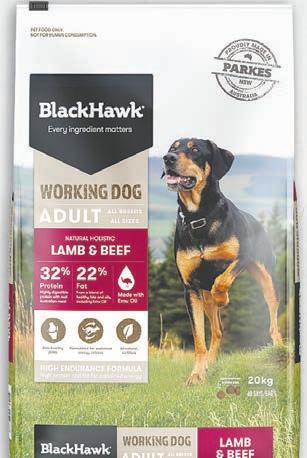

 Annette Scott NEWS Environment
Annette Scott NEWS Environment
FARMING in the “sensitive lakes” area of the Ashburton high country has its added challenges for extensive sheep and beef farmers.
More than 50 farmers were joined by Environment Canterbury (ECan) representatives to try to talk sense around water quality issues that have become an ongoing frustration for farmers and recreationists alike.
The day was the Federated Farmers annual high country big day out hosted by Erewhon Station, one of four high country stations tangled in the water quality web.
Kick-starting the discussion amid the vastness of the region, Castle Ridge Station farmer and Ashburton Lakes catchment group chair Kerry Harmer outlined the longstanding issue that the landowners have been “doing stuff about for a very long time”.
In early 2023 a catchment group encompassing the 13 Ashburton high country lakes and 58,000 hectares over four extensive sheep and beef properties was formed.
The catchment also takes in New Zealand’s Te Araroa walkway and many recreational hunting, fishing, water sports, tramping and snow opportunities, enjoyed by tourists and many people in the wider Canterbury community.
“Long considered an area of significance to the national and local iwi, our catchment has been under the spotlight recently due to concerns of deteriorating lake quality, something we as landowners have been concerned about and are acting upon,” Harmer said.
While at the moment the heat is on farmers, Harmer said the farmers are only part of the problem.
“It is a multilateral group working on the action plan for the area and everyone has to play a part.
“We [farmers] are focused on the
part we do play; we are working to do better and making sure we are making a difference.
“We could spend millions of dollars on fencing but will it make a difference? That’s what we need to know.”
Since September 2023, the farmers have been measuring water quality where the water enters their properties.
Nitrate levels range from less than 0.002ppm to 1.05ppm, which is extremely low, with some less than 10% of the nitrate levels in the drinking water of the Ashburton town water supply.
“Now here’s one for you: at a recent meeting in Ashburton the water from our creek and the water jug on the table were tested and the water jug was 10 times higher in nitrates than our [farm] tested creek water.”
In 60% of areas measured the water quality does not change or actually improves as it travels through the properties.
In 40% the water quality deteriorates slightly as it travels through the properties.
In all cases Harmer said this relates to the addition of spring water to the streams along the way.
“We are researching this to identify the source of the nitrates whether it be animals, nitrogen

fixation, organic matter breakdown or from parent rock material and the age of this water.
“We hope that with this information we will be able to find ways to reduce the nitrate levels coming from the springs. Meantime what we do know is there is a whole lot of hydrological

stuff we have a lot of work to do on.”
Although winter feeding systems are less intensive than elsewhere, the landowners are undertaking a monitoring programme to determine the actual loss from crops.
Don Whyte heads Whyte Farming, which farms two of the four impacted properties, Mt Possession and Hakatere Stations.
“We had to get regulated to get a consent to farm and in my case it took two years and cost us $36,000.
“We became a focus [of ECan], driven by the sensitive lake red zone.
“It’s a bit tough and not fair when there are bigger things happening creating the water problems than the farming of four families.
“Unfortunately, we are in the frontline and our draft consent conditions suggest sheep be excluded from sensitive farming areas a well as deer and cattle; this is under our consent to farm with ECan that is heavy handed with over regulation.
“For us 95% of our area is sheep – we run 15,000 sheep. To fence it
would cost in excess of $1 million and then stock water, a reticulated system would be damn near impossible,” Whyte said. Erewhon Station has been water testing for the past 10 years.
We [farmers] are focused on the part we do play; we are working to do better and making sure we are making a difference.
Kerry Harmer
Castle Ridge Station
“Our testing is proving a lefthand threaded anti-farming agenda,” Colin Drummond said.
Drummond expressed concern as to just what, where and how ECan is testing to get results that farmers are the problem.
“With 90-100 cows over 10,000ha there is immeasurable impact on water quality and 26 years of exclusion hasn’t changed Lake Emma.
“We don’t need to leave this area, if we did would it change? – I think not,” Drummond said.










Beef + Lamb New Zealand is focused on providing significant return on investment for dairy farmers’ beef levies.
The dairy, sheep and beef industries are linked, through activities such as:
• non-replacement dairy calves in beef finishing
• the provision of beef semen or bulls
• grazing young stock
• wintering dairy cows
• providing feed.
Cull cows are a significant source of NZ’s exported beef
Given these relationships B+LNZ continually looks at further opportunities for integration between the sectors We work collaboratively with DairyNZ and others such as Federated Farmers in areas of mutual concern and to avoid duplication of resources
Some of our work is specifically focused on dairy while we frequently run a dairy lens across other B+LNZ work
What levies do dairy farmers pay?
Dairy farmers pay beef levies on cull dairy cows ($5 20 per head at slaughter)
Beef levies are also paid ($5 20 per head at slaughter) on cull dairy heifers and bulls No levies payable on bobby calves

How much do dairy farmers pay in beef levies?
On average, dairy farmers pay around $425 a year in beef levies In total dairy farmers accounted for around 15 percent of B+LNZ’s levy income in the 22/23 financial year
On average dairy farmers pay around 15% Dairy farmers account for around 15 percent of B+LNZ’s levy income
$425 per year
How are dairy farmers’ beef levies invested?
B+LNZ invests levies in two main areas:
• post-farm-gate investment that seeks to maximise the value of animals sent for slaughter
• on-farm research and extension investments where we need to take a leading approach to addressing challenges or there are industry-wide issues to solve
The largest investment is on-farm research and extension, including:
• R&D and extension aimed at eradicating Facial Eczema from cattle in NZ
• internal parasite research and extension to reduce the risk of drench resistance and optimise the use of drenches and other management tools to minimise impacts on cattle production
• genetics research and tools to maximise the value dairy farmers can capture from the use of beef genetics
• collaborating with other industry players on how the value of non-replacement dairy calves is maximised


Post-farm-gate investment is focused on:
• opening up new market access for beef by advocating for and supporting the government’s negotiation of Free Trade Agreements (FTAs)
• advocating with government and internationally for the removal of non-tariff trade barriers that reduce farmer returns
• international advocacy and collaboration on issues that threaten livestock farming and our beef industry
• research into the unique nutritional attributes of NZ grass-fed beef
• promotion of NZ beef and its attributes in international markets
• promotion of beef consumption domestically, in partnership with processors and retailers, and growing the trust and reputation of NZ beef production systems



Mark Mitchell and Todd McLay had better show a clean pair of heels when they play against a bunch of farmers in this month’s charity rugby game.
Gisborne sheep farmer Toby Williams reckons the two politicians will be in his sights during the Federated Farmers versus Parliament match, being held to raise funds for Cyclone Gabrielle-hit farmers.
“I’m a bit disappointed Andrew Hoggard (former Feds president turned MP) isn’t playing now because of his eye injury. I was hoping to give him a bit of niggle.
“We’ll have to find someone else and I reckon Todd McClay (Minister of Agriculture) and Mark Mitchell (Minister of Police) are the ones,” Williams says.
“Mark does look pretty fit, though, and he’s a former police dog handler and member of the Armed Offender’s Squad. I need to find someone smaller than me. I was hoping Winston Peters or Damien O’Connor might have been running on, but I’ve had no such luck.”
Williams, Federated Farmers national meat and wool chair, is only joking of course, and admits to having a few nerves about packing down in the front row alongside Federated Farmers president Wayne Langford and national dairy chair Richard McIntyre.
He’s played one game of rugby in his life, about 30 years ago, for the Fifth XV at Christ’s College in Canterbury.
“I was stuck out on the wing and it wasn’t because I was fast – it was so I never got the ball.
“I ended up getting flattened by this fella and that was the end of my short and undistinguished rugby career – until now.
“I’m happy to pull on a pair of boots for a good cause. I just hope the jerseys fit a little bit better than the ones DairyNZ used last year!”
Federated Farmers has organised the fundraiser rugby and netball tournament in Gisborne on May 25 to show support to East Coast farmers, who’ve copped more than their share of hardship in the past year.
Williams says Federated Farmers originally set out to raise $100,000 to $150,000, but the goalposts have shifted.
“We’ve had some incredible support from Woolworths New Zealand, and then from a local charitable association, so we’re currently sitting at around a quarter of a million dollars.
“We’ve lifted our target to $300,000 but even if we don’t get much more than what we have now, it’ll be an incredible help for 100 or so farmers in the Gisborne and Wairoa regions.”
The funds will be used to purchase fencing equipment for farmers still rebuilding their properties after Cyclone Gabrielle.
“It’s been a tough year for farmers down here, not just with weather events but also because it’s been such a hard time financially for farming.

“It’s a little bit of support but everything helps.”
Federated Farmers partner FMG have generously donated all the rugby and netball uniforms.
Local businesses have got in behind the cause, paying for sponsorship on the back of each uniform.
Woolworths are sponsoring the post-match function, for which tickets are also being sold to help raise funds.
Williams says the event isn’t just about raising funds, though.
“It’s free to come along to the
games and there’ll be some lunch for free.
“This is just a bit of fun and it’s about bringing the community together for a good cause and a good time after a tough few years.
“The big thing with this game is that we want it to be a full stop after Cyclone Gabrielle – this is the end. We need to focus on some new things and new challenges.
“This is just a small token of support and appreciation for our East Coast rural communities.”
The games are being played in memory of the late Parekura
Horomia, who hailed from the East Coast and was Minister for Māori Affairs between 2002 and 2008.
There will also be a special ceremony at halftime where Federated Farmers and CNH Industrial will be giving away a tractor and post-rammer to a deserving family impacted by Cyclone Gabrielle.
Case IH and New Holland donated two tractors last year to help restore fencelines on farms in Gisborne and Hawke’s Bay.
A second tractor will also be given away at the Hawke’s Bay Farmer of the Year competition.
Williams says there are some big names running out in the rugby and netball teams, including Simon Watts (Minister for Climate Change), Peeni Henare (Labour MP), Louise Upston (Minister for Social Development) and Barbara Edmonds (Labour MP).
“Everyone is really getting in behind it and no matter the score on the day, our community are going to be the winners.
“The fundraising efforts are going to make a huge difference for farmers in Gisborne and Wairoa, and we’re incredibly grateful for the support.”
Get along to the Ngatapa Sports Club in Patutahi on May 25.
Lunch is from 11am, the netball starts at 12:30pm, the rugby kicks off at 2pm.
MORE:
Enquiries to Toby Williams: 021 236 7909, twilliams@fedfarm.org.nz



Methane targets, freshwater rules, banking issues and farmer confidence are all up for discussion at a new one-stop shop for advocacy issues at Fieldays 2024.
Federated Farmers and Fieldays have teamed up to launch a Rural Advocacy Hub, bringing together all the main advocacy groups who speak up for Kiwi farmers.
The Hub builds on Federated Farmers’ broader vision to unite rural advocacy groups as one team to support farmers, president Wayne Langford says.
“Farmers want to see the different farming advocacy groups working together constructively to get the best outcomes we can for our rural communities,” Langford says.
“This Hub will bring all of those players together under one roof for the first time, and we look forward to continuing to build on the concept in future years.” Langford says the various advocacy groups have different

roles to play but need to be working together and communicating well.
“If we work as a team, with everyone playing in the right position, we can achieve a lot more for farmers than any one organisation can working alone.
“If we don’t work together well, we risk knocking the ball on – and farmers will be the ones who end up losing.”
The Rural Advocacy Hub will serve as a central platform for discussions, announcements and initiatives to amplify the voices of farmers and rural communities.
Exhibitors include Federated Farmers, Young Farmers, Groundswell, Rural Women, Future Farmers NZ, Farmers Weekly, and many more.
New Zealand National Fieldays Society chief executive Peter Nation says it’s great to be able to work alongside Federated Farmers to deliver a dedicated advocacy space like this.
“This new Hub delivers on Fieldays’ purpose of advancing agriculture through both education and collaboration,” Nation says.
“We know it’s incredibly tough out there this year. It’s never been more important for farmers to be heard and to have advocates amplifying their voice.
“Federated Farmers are New Zealand’s leading rural advocacy organisation, so they were a natural fit for us to partner with to bring the Hub to life.”

On Monday the 6th of May a crowd of 50 farmers packed into a small hall in Taumarunui for the Ruapehu Federated Farmers provincial AGM.
While those numbers may sound small to some, it was a remarkable turnout for a small province whose population are scattered sparsely across a vast geographic area.
So, why did so many farmers jump in their utes and make the long drive after a hard day’s work on the land? The local provincial president Robert Gray says it all comes down to connection.
“It’s been an incredibly tough season for many of our local farmers and I think a bit of a social occasion is just what we all needed,” says Gray.
“The weather has been pretty good this year and the stock are in great nick, but it’s just not translating into much of an income for our farming families.
“Low sheep meat prices and rising
costs have really hit farmers in the back pocket, and we’re starting to see that flow through to the other rural businesses in our community.
“It was great to be able to get together, share a meal, and have a beer.
This is one of the best turnouts I’ve even seen for an AGM. The locals are clearly passionate about Federated Farmers and the work we’re doing.
drive from Gisborne to address the crowd.
The main topics of conversation? Rural banking, rising rates, and the impact of land use change on their community.
“This is one of the best turnouts I’ve even seen for an AGM. The locals are clearly passionate about Federated Farmers and the work we’re doing,” Williams said.
“They’ve got a small but dedicated executive who are working closely with their neighbouring provinces and delivering some real results.”
Local MP Suze Redmayne, Horizons councillor Nikki Riley, and Ruapehu mayor Weston Kirton were all in attendance and spoke highly of the work Federated Farmers are doing both locally and at the national level.
“This is the kind of grassroots community stuff that Federated Farmers do best.”
It wasn’t just local farmers who turned out in numbers either, with Federated Farmers meat & wool chair Toby Williams making the
There were also positive signs of progression happening in the province with 33-year-old sheep and beef farmer Nathan Blake, who farms with his wife Libby near Taumarunui, stepping into the vice president’s role.




Young farmers aspiring to own a farm should consider off-farm investments as one way to build their equity for a deposit, a financial adviser says.
Forsyth Barr’s Michael Raynes says there are credible alternatives for growing capital outside of traditional pathways like sharemilking or simply saving money in the bank.
“If you’re building up towards ownership of a farm, that in itself comes with a concentration of risk because you’re very much tied to commodity cycles.
“Off-farm investment, particularly as a way to build wealth, is something for people to consider.
“It’s good for diversification and accessing other opportunities.”
Raynes, who joined the Federated Farmers Podcast, encourages young farmers to think about putting some money into a managed fund.

That allows them to pool their money with other people and invest in a wide range of assets.
“If you’re starting out small or you have some surplus cash, managed funds are a great way to get started.
“You’re getting better diversification than you could by buying one or two shares on your own.
Your money isn’t locked in. That flexibility and access to capital is really important when an opportunity comes up and you want to capitalise on it.
Michael Raynes Forsyth Barr“Most managed funds in the New Zealand market will be Portfolio Investment Entities (PIE), which
provide certain tax benefits for investors too.”
Being able to access that money easily is another advantage, he says.
“Your money isn’t locked in. That flexibility and access to capital is really important when an opportunity comes up and you want to capitalise on it.
“That’s a way to make your money work a bit harder for you than simply having it sitting there in the bank earning interest, which is capped.”
Raynes says KiwiSaver is another tool for young farmers to grow their wealth, providing a structured and disciplined way to save.
“I think young farmers should absolutely have KiwiSaver as a plank in their savings and retirement plans.
“Your employer’s required to put in a minimum of 3% if you are, and as

long as you’re putting in effectively $20 a week, you’ll get the $10 a week from the Government, which is up to $521 a year. So, it’s always nice to get something back from the Government.”
Raynes says he’s aware Federated Farmers and others have been asking the Government to change the rules so young farmers can use their KiwiSaver to buy their first farm.
BANK IT: Forsyth Barr’s Michael Raynes encourages young farmers to think about putting some money into a managed fund.
That’s an “interesting concept”, he says.
“The farm and the house often go together, right? It’ll be interesting to see where that conversation goes, and I think it’s one worth having.”
MORE:
Hear the full podcast, in which Raynes also shares investment advice for farmers exiting farming, at fedfarm.org. nz/podcast
How New Zealand can grow its trade with India and the challenge of Scope 3 emissions and consumer expectations are among topics to be confronted at this year’s Primary Industries New Zealand (PINZ) Summit.
It’s the sixth time some of New Zealand’s most influential primary sector leaders will gather for presentations and discussions focused on how to build a resilient and productive future.
The summit, at Tākina Wellington Convention and Exhibition Centre from July 2-3, is also a chance to celebrate the sectors’ innovators and
leaders with the annual PINZ Awards, Federated Farmers chief executive
Terry Copeland says.
“These are tough times for our food and fibre producers, many of them putting in long hours to keep businesses going in the face of rising costs and variable returns.
“But taking two days out for the annual PINZ summit to hear what directions our best and brightest are pursuing, and to catch up on latest thinking on everything from genetic modification to new wool prospects, is an investment in everyone’s future,” Copeland says.
Local and central government leaders, including Minister of
Agriculture and Trade Todd McClay, will discuss what they’re doing to smooth obstacles frustrating farmers and growers. Experts from MFAT, MPI and processors will outline latest developments.
Keynote speakers include Silver Fern Farms chief executive Dan Boulton, Nestle NZ country manager Jennifer Chappell, Fonterra chief executive Miles Hurrell, MPI director general Ray Smith, Rabobank NZ chief executive Todd Charteris, Ministry of Foreign Affairs and Trade deputy secretary, trade and economic Vangelis Vitalis, and Federated Farmers national president Wayne Langford.
The PINZ Awards evening is always a fun night and this year there have been more nominations than ever in the ‘Outstanding Contribution’ and ‘Team & Collaboration’ categories. The team of judges, including 2023 Kaitiakitanga Award winner Adam Thompson (Restore Native) and Emerging Leader Dr Louise Hennessy (AgResearch), are hard at work assessing entries.
Finalists are due to be announced at the end of May.
MORE: Full details on the 2024 PINZ Summit and Awards are at primaryindustries. co.nz

Ripping up sealed roads and reverting to gravel because of the damage being done by logging trucks is a move back to the Middle Ages, Jarred Coogan says.
“It’s akin to the McGillicuddy Serious Party’s ‘great leap backwards’,” the Taranaki Federated Farmers executive member says.
New Plymouth District Council (NPDC) is planning to turn a 6km stretch of the sealed Tarata Road back to gravel.
Coogan says doing so would create a serious safety risk and dust nuisance.
“We have a school bus, farmers’ utes and family vehicles currently sharing the road with dozens of 50-tonne fully laden logging juggernauts each day.
“I’m really worried about the risk of a crash or serious accident resulting from this road going back into gravel with a loose stone surface.”
He says the 18 families along the road would also end up with dust coating their washing lines and houses, and water quality will be degraded for those who collect rainwater from their roofs.
“Dust can also cause significant negative impacts on crops and pasture,” says Coogan, who shared his views at a NPDC Long-Term Plan (LTP) meeting on May 2.
Tarata Road might not be the only rural road turned back into gravel.
The council’s LTP states roads associated with forestry movements have not received any investment, resulting in a rapid deterioration of these roads.
“We are changing these roads from sealed to unsealed, which will reduce ongoing costs for forestry roads by a third,” the plan reads.
While the council wants to double investment in transport infrastructure renewal from $146m to $307m over 10 years – a move Federated Farmers applauds –cost inflation will take a huge bite.
NPDC admits the increased spending will, overall, enable it

UNSUPPORTED: NPDC’s claims that gravel roads used by heavy trucks will cost one third less than sealed roads to maintain were not accompanied by any evidence, Federated Farmers local government policy specialist Nigel Billings says.
We are changing these roads from sealed to unsealed, which will reduce ongoing costs for forestry roads by a third.
New Plymouth District Council Long-Term Plan
only to maintain existing levels of service.
Elsewhere in the LTP, the current condition of road assets are rated as “average but deteriorating”.
Of 1313km of road in the district (966km in rural areas), all but 168km are currently unsealed.
Federated Farmers local government policy specialist
Nigel Billings says in his 25 years monitoring the sector, he’s never come across a council planning to rip up a sealed road.
“You’re never going to come back and seal that road again.
“[New Plymouth Mayor] Neil Holdom has solid infrastructure investment credentials – that’s how he got elected.
“So, there’s something very wrong with this sealed-roads-to-gravel picture on the council side.”
Billings says NPDC is by no means the only local authority “caught with its pants down” over roading.
“Investment has been insufficient for years, including from central government. And now that maintenance and renewal costs have ballooned, many councils are finding they just don’t have enough money.”
It’s an echo of the Three Waters infrastructure backlog up and down the country, he says.
“What Federated Farmers are advocating to councillors in many districts is a ‘no-frills’ attitude. It’s time to focus only on those core council responsibilities.”
NPDC’s claims that gravel roads used by heavy trucks will cost one third less than sealed roads to
maintain were not accompanied by any evidence, Billings says.
One option for New Plymouth is to look at Wairoa District Council’s move to increase the forestry rates differential, to recognise the costs that industry imposed on other ratepayers, particularly via damage to roads, he says.
As a result of the change, the 2023 rates bill for owners of the 77,000ha of forest in the Wairoa District increased from $1.59m to $2.79m.
“Federated Farmers has pushed for those differentials. It’s not an antiforestry thing; we’re all about costbenefit,” Billings says.
“If you’re running a business, and you cost council an awful lot of money, you should pay that cost.”
Milk tankers and cattle trucks take a toll on roads too, but rates bills of $10,000-$15,000 for farms are typical, with a large roading component, because farm land is rated according to its highest ‘best use’.
That’s also the case for kiwifruit
growers, who pay on a basis taking in the value of their growing licences, and orchardists.
“Forestry gets away largely scotfree,” Billings says.
“You’ve got land value based on international log prices and that’s useless for any other purpose.”
Billings says other councils are starting to follow Wairoa’s lead, with Stratford District Council the latest to raise forestry rating differentials. On other fronts, Federated Farmers is encouraged by the New Plymouth council’s LTP.
While it plans to reduce the Uniform Annual General Charge – a move contrary to Federated Farmers’ policy – the council is proposing changes to the differential that will see farmers paying between 2.2 and 20.1% less in general rates in 2024/25.
Federated Farmers have also welcomed NPDC’s intention to accelerate stormwater catchment management planning and investment.


Rural opportunity with huge potential


3 1 1 1
41 Karapiro Road is situated in a private secluded setting and is nestled by nature. Conveniently located 8.5 km from Cambridge and 6km from Lake Karapiro. Embrace the opportunity to make this property your own haven, combining the tranquility of rural living with the convenience of nearby town amenities This three bedroom home sits upon 25.17 ha.
The effective area is circa 13.17 ha consisting of multiple paddocks and central race system The property benefits from brand new high spec post and rail fencing throughout. A horse arena, stables, shedding, turnaround, stockyards, weighing and loading ramp make stock management a breeze. The balance of the property consists of two gullies, flooded with nature and a plethora of wildlife The gullies are accessible by track and are ready for you to explore. The creeks encompass two beautiful waterfalls and a number of small ponds. There is further potential for development with regard to the ETS should someone wish to go that way.

Property Brokers are proud to bring to the market this very attractive 57.98 ha bare land property located on State Highway 45 at Otakeho. The property is currently used to graze young stock and harvest pasture silage but could also be an ideal maize block, beef finishing unit or a larger lifestyle block The contour is flat and well subdivided into nine paddocks via a central race. Facilities include a tarseal drive an old cow shed converted into simple cattle yards and a loading ramp. Water is provided by the Waimate West water scheme
Bordering the South Taranaki coastline it features outstanding sea views and beach access with a 'Spot X' fishing location just offshore A well located support block in a strong dairy farming area.
Deadline Sale closes Thursday 30th May, 2024 at 3.00pm, (unless sold prior)
View Thu 16 May 2.00 - 3.00pm Thu 23 May 2.00 - 3.00pm Web pb.co.nz/CBL119518


Russell Thomas M 020 4004 0360 E russell.thomas@pb.co.nz
Angela Thomas M 020 4004 0368 E angela.thomas@pb.co.nz


Auction 11.00am, Tue 4th Jun, 2024, (unless sold prior), Otakeho Hall, Auroa Road, Kaupokonui
View Thu 16 May 11.00 - 12.30pm
Web pb.co.nz/NPR180971

Greg O'Byrne M 027 598 3000 E greg.obyrne@pb.co.nz
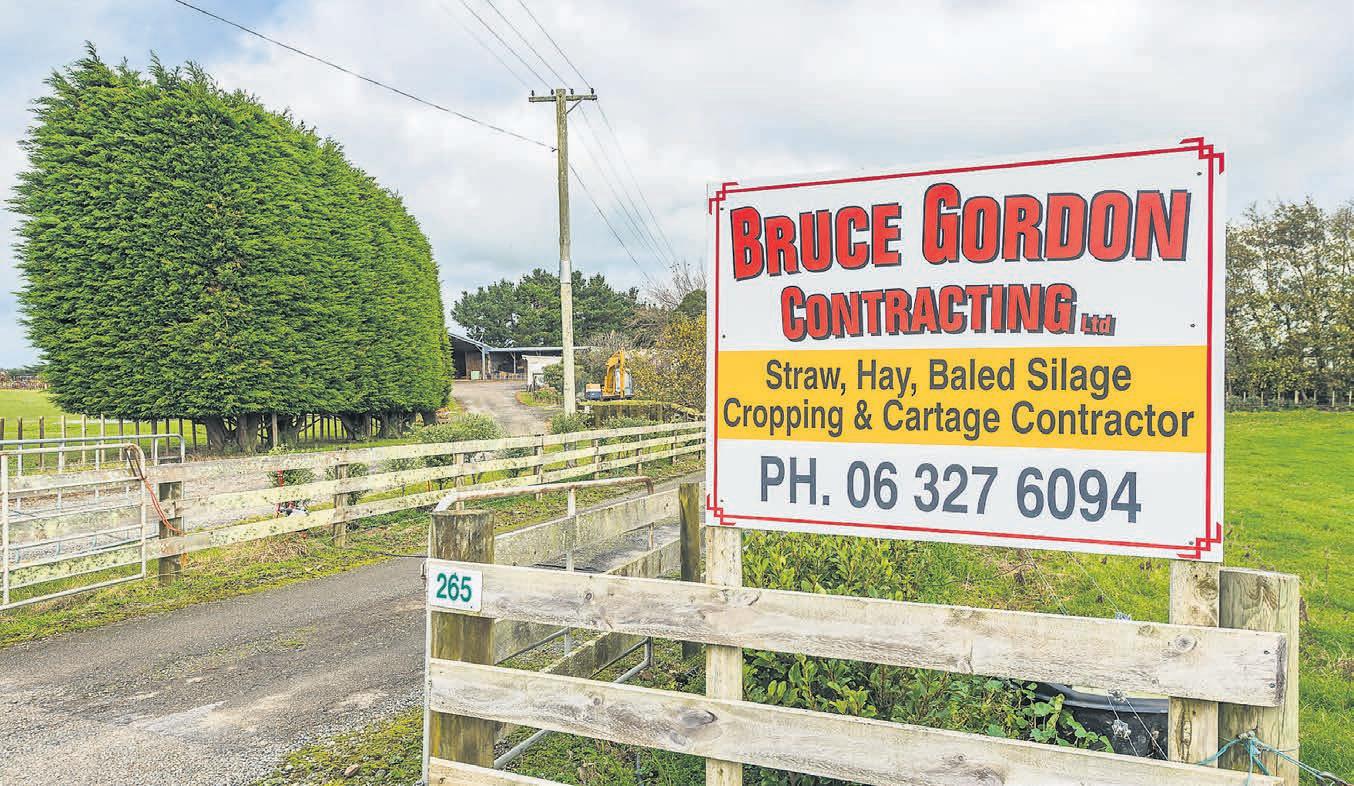
With more than 40 years in operation, this consistently profitable business is serving a profitable client base, across a broad range of agricultural services. The modern fleet of machinery and equipment is well maintained and serviced and provides the ability to complete all the work in-house The long established business runs with three fulltime staff including the owner and operations manager and additionally they use the services of a fulltime / part-time staff member. Offering cultivation and baling services as well as a general freight service, the business also provides a comprehensive baled feed supplement supply and carry a year round supply in stock. A fully and well appointed depot of approximately 7,000 m2 is available to lease, for machinery and produce storage (conditions apply) Complement your existing operation or step up into a fully operational business showing consistent financial profitability.

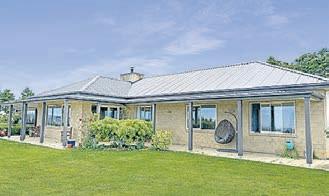
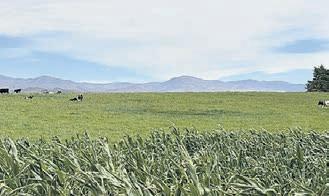


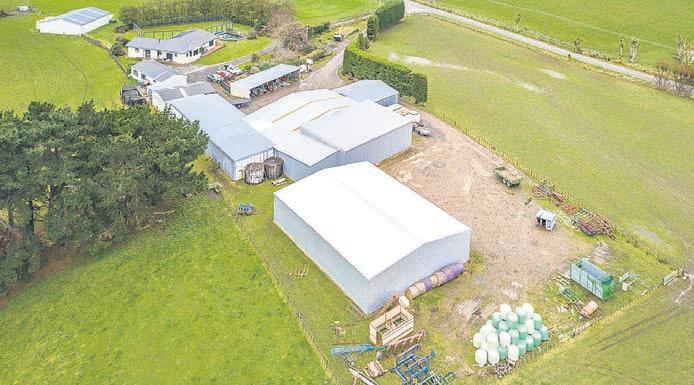

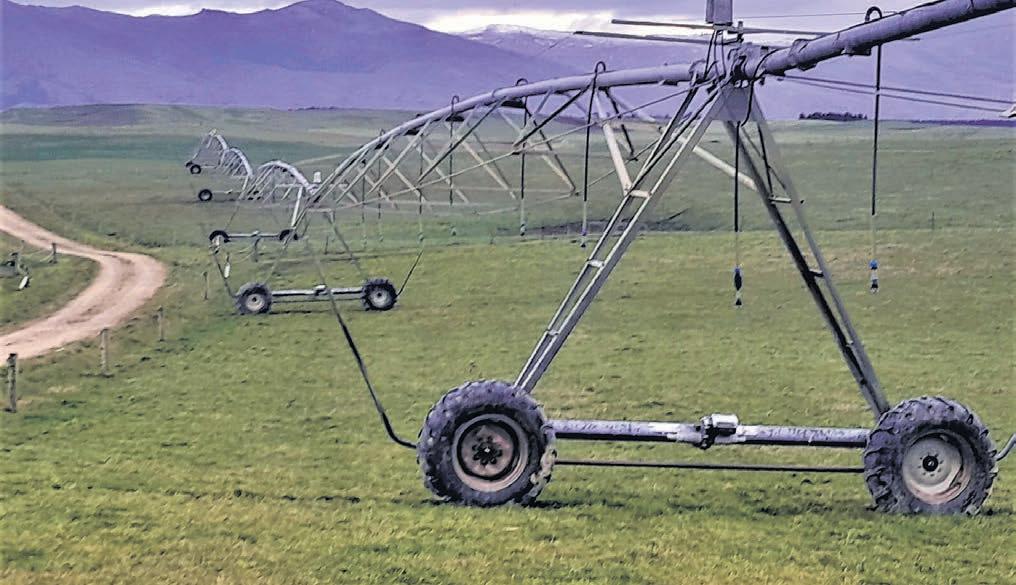







Located 12 kilometres North of Kimbolton 'Flock Hill' is 869 hectares in 15 Titles primarily utilised as a sheep breeding unit with options to sell in blocks or as a whole The farm has access from Rangiwahia & Bluff Road and contour ranges from a mix of easy to medium hill with the balance being developed flats and steeper hill
The property benefits from excellent access with metalled main tracks and the farm is well subdivided with ongoing fence maintenance programs in place Further improvements include two dwellings, with the main home being four bedrooms set in mature grounds, a modern eight-stand woolshed with covered yards, plus two additional woolsheds, satellite yards, and an airstrip with concrete bunker Flock Hill provides an opportunity to secure a well-positioned hill country farm offering scale in the Manawatu bayleys co nz/3100622



Tender (will not be sold prior)
Closing 1pm, Thu 30 May 2024
49 Manchester Street, Feilding
View 12 30-1pm Thu 16 May
Mark Monckton 021 724 833
mark monckton@bayleys co nz
Jack Monckton 027 394 3705
jack monckton@bayleys co nz


A dairy farm with a fine lineage, amazing stewardship and future potential Braeside Dairies comprises 433ha of land that is held within 12 titles The portfolio of prime flat land with high class soils and an excellent array of infrastructure is beautifully sited between the Manawatū River and the ranges close to Palmerston North This is a truly generational opportunity for new custodians to own a superbly maintained and faithfully-farmed large scale dairy farm with an exceptional production record One of the most impressive dairy farms in the Manawatū, Braeside milks approx 1,400 cows with an average production of 662,133kgMS The farm has been extensively fitted out with no expense spared and supports top-of-the-range infrastructure including a modern 80-bail rotary, extensive calf-rearing facilities, five well-maintained homes, and a high standard of fencing and laneways bayleys co nz/2315393





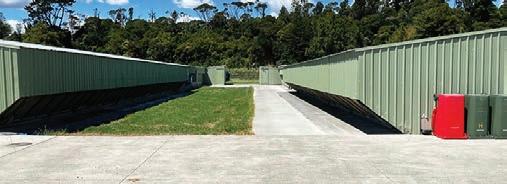
Located at 29A Arrowville Road, Pukekohe on 7.0320 hectares of flat land are four quality broiler chicken sheds, with a total 8528 square meters, running close to 150,000 chickens per run. The sheds have the latest equipment and strong maintenance programme, which keeps this farm in top order. The office block has the usual amenities, including the generator room and pumping station. The stunning four bedroom house has been completely refurbished, with new kitchen, bathrooms (2) carpet and a large deck around half the house from which the rural vistas are impressive.
Contracted to Van Den Brinks Poultry Ltd who have been operating for 60 years in NZ, a company that has the following motto: quality, integrity, positive attitude, accountability, honesty and prosperity. Chicken farming has proven to be robust, and reliable with consumption surpassing that of beef. An editorial in the Washington Post in 2014, said that chicken consumption throughout the world would outstrip other meat by 2023, this happened years earlier.
If you are considering a change in your life, then chicken farming will change your lifestyle. This would suit a farming family who enjoy rural life and working from home without long extended hours. Even if you are just thinking of a change, then please call and discuss this opportunity. The agent has previously been a chicken farmer and is able to give a complete insight into chicken farming. You are welcome to call and discuss this success story. Owner motivated to sell.



















Holiday home in great location - Central Waikato. Ideal for Fieldays, sporting or family events
5 kms to Tamahere Village; 10 kms to Hamilton 10 kms to Fieldays/Airport; 10 kms to Cambridge
Executive style 4 bedroom home set in peaceful, private grounds with mature trees and in-ground pool
Spacious kitchen and living spaces fully spec ’d with modern appliances, expansive outdoor living basking in north -facing sun great heating & cooling p lus ample undercover parking
5 guests; minimum 3 night stay over Fieldays (no pets/parties)
Contact Owner:Brian Peacocke 021 373 113 / bjp@prl308.co.nz For more info visit:www holidayhouses co nz keyword: Tamahere





On Account of P J Brogden Contracting Ltd 110 Awakeri Rd, RD 3, Whakatane TUESDAY 28th MAY – 10.00am
Viewing: Monday 20th & Monday 27th May 10.00am-3.00pm both days and 8.30am day of sale
Due to the owners deciding to restructure their business they are offering for sale quality late model Agricultural equipment that has been well maintained and is presented for sale in excellent condition.


Items include: JCB Farm Master 435S, Massey Ferguson 7724, CASE Puma 220 x 2, CASE Puma 240, Bednar Omega Seeder 6000L, Krone Big X1100 Harvester, Krone Big X850 Harvester, Kuhn FBP 3135 Balers x 2, Claas Disco 8500c Mower, Claas Liner 3600 Swather, 2013 Freightliner Argosy 8x4 with Tipping deck & TMC 4 axle split deck tipping trailer, Smyth 18t Tractor Trailers x 4, Alpeego Power Harrow, Strautmann Hopkins muck spreader, Scania ground spreader truck and more.
and Online bidding
For further enquiries





















Board
Arohiwi Station is wholly owned by Presbyterian Support East Coast (PSEC ), a registered Charity. The proceeds of Arohiwi Station are used to support PSEC’s social service delivery on the East Coast. PSEC seeks a fth Board Director to join the four existing Board Directors.
Arohiwi Station is a highly regarded breeding and nishing sheep and beef operation situated on 1,488.5ha in the Puketitiri District, approximately 56 kilometres North-West of Napier. Further details regarding Arohiwi Station are found on the PSEC website.
https://www.psec.org.nz/about-psec/arohiwi-station
The primary purpose of the Arohiwi Station Board Director Role is to act honestly, in good faith and in the best interests of the company. To support the company and its sta in ful lling its purpose and discharging its accountabilities.
Arohiwi is looking to adopt a continuous improvement mindset to evolve and diversify into the future. Interest is sought from those who have:
• an agri-commerce background,
• understanding of sheep and beef farming,
• environmental management and development, and the forestry/carbon market,
• experience in the development of new business initiatives and
• an understanding or experience in NGO governance.
This is a remunerated position commencing mid-2024. Information on the Directors role, responsibilities, attributes, and skills required is available by contacting: Jo Wilkinson PSEC Board Secretary jo.wilkinson@psec.org.nz Expressions of interest close 30 May 2024.



Bring your own 4X4 on a guided tour to discover more of the South Island.
Tour 1: Tour 1 Molesworth Station, St James, Mailings Pass & Rainbow Stations
Dates: Nov 11-14, Feb 3-6, 17-20, March 17-20, 24-27, April 7-10, 14-17
Tour: 2 D’Urville Island & Marlborough Tour
Dates: Feb 19-23, March 24-28
Tour 3: North Otago Tag-along Tour
Dates: March 11-15
Other dates could be available for groups of 6 or more people on request.



harvested giant kelp. The world’s richest source of natural iodine. Dried and milled for use in agriculture and horticulture. Growth promotant / stock health food. As seen on Country Calendar. Orders to: 03 322 6115 or info@nzkelp.co.nz
WORD ONLY ADVERTISING. Phone 0800 85 25 80.

AWATERE B TRUST is calling for tenders to lease their property at Marangairoa Road, Te Araroa. The grazeable area of 350 hectares is a mix of easy rolling to steep hill country and includes 70 hectares of flats. The Committee seeks tenders from interested parties to take over the property from 10 February 2025. The final terms and conditions of the lease will be negotiated between the committee and the preferred lessee. Interested parties will need to request an information pack from BDO by 4 pm Monday 20th May 2024. Initial applications close 4.00 pm Friday 24th May 2024. For an information pack email: BDO Gisborne, MBU@BDO. CO.NZ
WILTSHIRES-ARVIDSON. Self shearing sheep. No1 for Facial Eczema. David 027 2771 556.

SHEEP SCANNING AVAILABLE
OVER 20 YEARS experience. Owner/operator. Three way draft. Marking included. Approved marker supplied. No mileage or set up fee. To identify empty/single/twins and lates if required .65c. To identify triplets please contact me to discuss best economical options. Areas covered Hawkes Bay, Taihape, Wairoa, Whanganui, Wairarapa, Central Plateau. Contact Greg on 027 588 900.
STOCK FEED
BALAGE $75 a bale +GST. Hay rounds 15 equiv. $85. Straw rounds, 15 equiv $60. Unit loads available. Phone 021 455 787.
WHAT’S SITTING IN your barn? Ford, Ferguson, Hitachi, Komatsu, JD. Be it an excavator, loader or tractor, wherever it is in NZ. Don’t let it rust. We may trade in and return you a brand new bucket for your digger or cash for your pocket. Email admin@loaderparts.co.nz or phone Colin 0274 426 936.
they arrived at the house later on, where an older woman answered the door and asked, “Can I help you?” Fred explained, “Yes, ma’am, I was here at your party over the weekend, and my friend Klaus here doesn’t believe me that you have a golden toilet in this house!” The woman then looked at them, turned to her hallway, and called out to her husband, “Hey Hermann, here’s the pig that relieved himself in your saxophone!”
Here at Farmers Weekly we get some pretty funny contributions to our Sale Talk joke from you avid readers, and we’re keen to hear more!
If you’ve got a joke you want to share with the farming community (it must be something you’d share with your grandmother...) then email us at: saletalk@agrihq.co.nz with Sale Talk in the subject line and we’ll print it and credit it to you. Conditions apply





On-farm bull sale Thursday 13 June

‘The Sale Shed’ 839 Maraetotara Road, Havelock North Follow our Facebook for updates
Open day: da 10am-am-2pm pm Thurs 23 May
Catalogue online now!
Chris & Jen Chesterman P: (0 6) 874 7844 M: 027 4777 637 E: info@koanuiherefords.co.nz


























On A/c J & S Webster (Waiau Trust)
29 Ohanga Road, Onaero, North Taranaki
THURSDAY 16TH MAY 12pm
Comprising:
37 High Index Incalf Dairy Cattle
Ave BW 372 PW 423
26 x Frsn, F/x Incalf Heifers
D.T.C from 23/7 having 3 weeks
AI nominated XBD & Jsy Sires and tailed with Jsy Bull Heifers BWS up to 526
8 x Frsn & F/x Incalf Cows
D.T.C from 23/7 having 7 weeks AI nominated XBD & Friesian Sires.
BWs up to 538 PWs up to 618
2 x Hrfd/Fsn Heifers
(Carrying Contract Embryo’s sexed F BW533)
Star Lot - 1 x Yearling XBD Heifer
Most possibly the highest yearling to be sold this year. BW665 PW605
Offering Includes 16 LIC & CRV contract matings.
All cattle have a C10 status & Lepto vaccinated.
Payment Terms 1/2 1st June 1/2 deferred 20th October 2024 or finance available on prior arrangement.
Grazing available till 1st June 2024
This sale will be livestreamed through
For catalogues contact Simon or Andrew
Vendor Jim Webster 027 414 0563
Simon Payne 027 241 4585

64 Alec Robins Rd, Queenstown Monday 20 May, 2.30pm
Mike and Gemma Smith
Mike 021 975 269 or Email: mike@kcangus.co.nz
PGG WRIGHTSON
Cullum McDonald 027 433 6443
Craig Knight 027 590 1331
John McKone 027 229 9375
John Duffy 027 240 3841
RURAL LIVESTOCK
Anthony Cox 027 208 3071
Paul Mavor 027 473 0100
Tony Pride 027 434 7230
ROGER KEECH GENETICS Roger Keech 027 417 8641
Inspection welcome at any time Food and












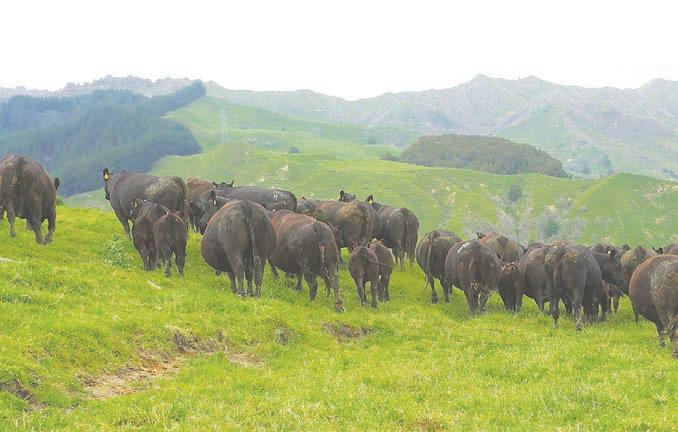
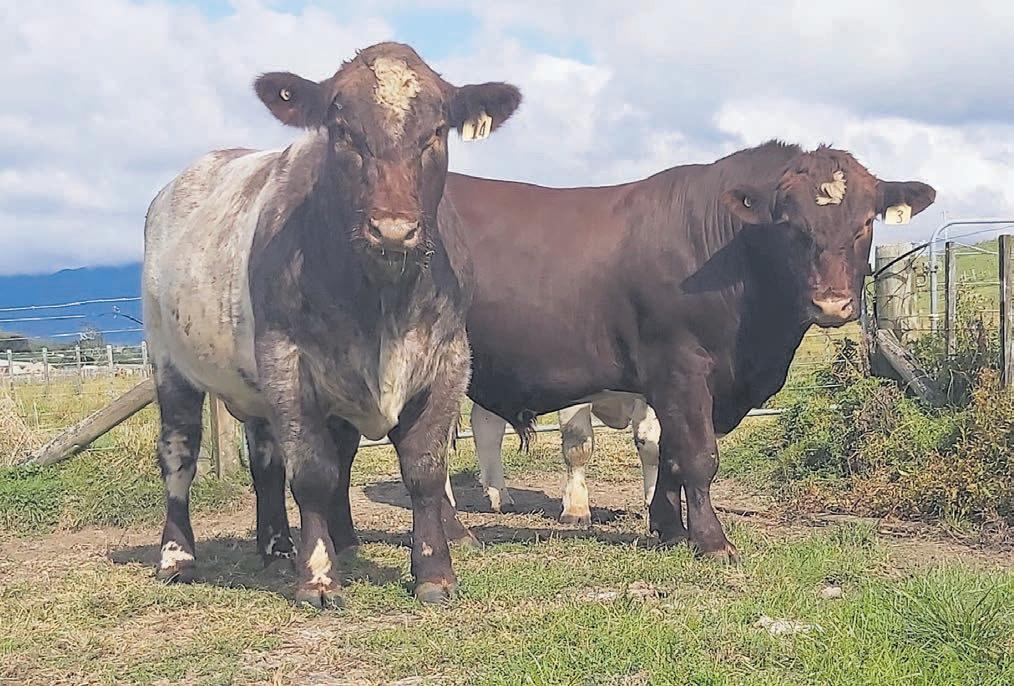











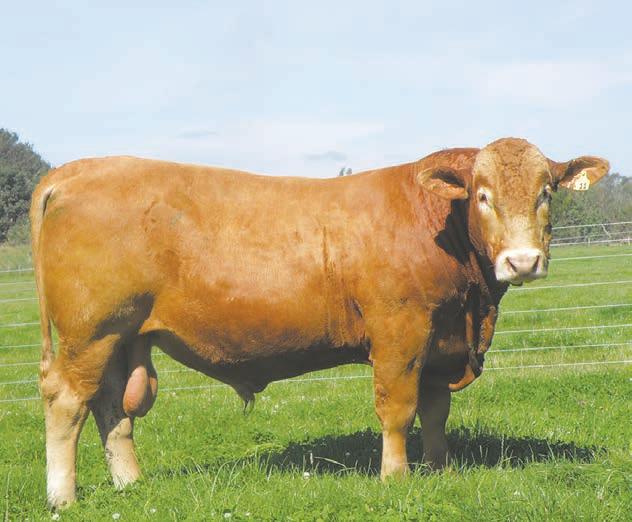
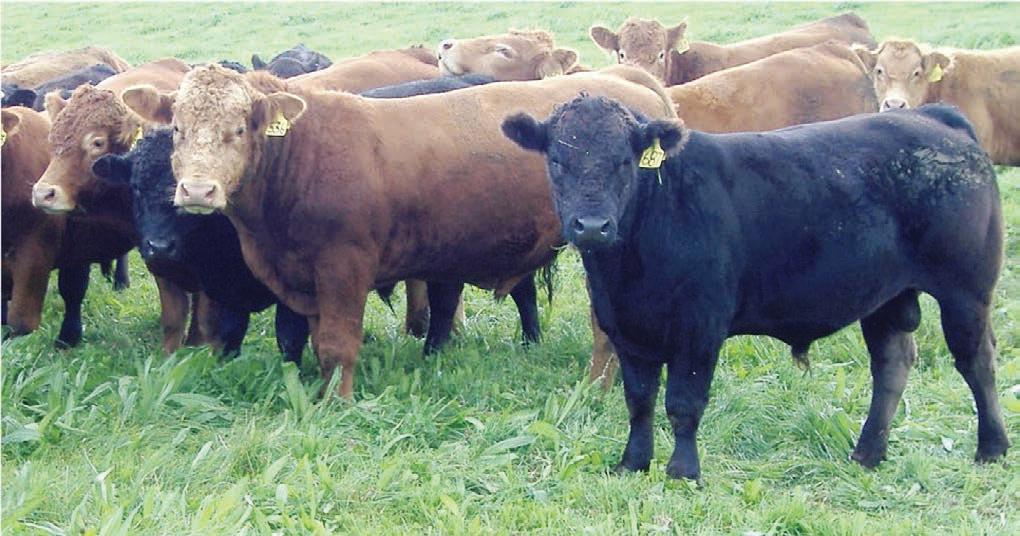
Saleyards
PGG Wrightson will offer 1900 Hill
Weaner Steers and Heifers
A&A Coogan Family Trust
50 Angus x Steers
Brian Coogan Family Trust
• 120 Angus & Angus/Hereford Steers
Riini Trust
100 Charolais Steers
Contact Gareth Williams - 0275 264 613
Devane Bros
100 Angus Steers
• 100 Angus Heifers
Contact Phil Transom - 0274 420 060
Ricky Alabaster Trust/Rangitane P/Ship - Taihape
325 Angus & Angus/Hereford Steers
325 Angus & Angus/Hereford Heifers Atahua & Kaharau Bred
Carey Alabaster - Taihape
• 120 Angus & Angus/Hereford Steers
30 Angus & Angus/Hereford Heifers Kaharau Bred
Hardrock Station
• 75 Angus Steers
• 50 Angus Heifers Atahua Bred
A&K Coogan
50 Charolais x Steers
• 50 Charolais x Heifers
C&N Alabaster Family Trust - Taihape
100 Angus & Angus/Hereford Steers
• 50 Angus & Angus/Hereford Heifers Atahua and Kaharau Bred
Contact - Maurice Stewart - 0272 469 255
Other Annual Lines
H Tapp, Ferriby Land Co, I&J Check ley, Wyeth-Reefhill Ltd, S Eames
Outstanding line of later born weaners from Nor thern Manawatu and Taihape







A great chance to see approximately 1100 R2 Bulls over four days that will be auc tioned this season.
Prior viewing would be available by arrangement with vendors, or the agents listed below
South & Mid Canterbur y Tuesday 21 May | 9am - 12pm
Orari Gorge Hereford, Geraldine, Rober t Peacock 03 6922893
Matatok i Hereford, Cave, Paul Scott, 027 296 3817
Merr ylea Hereford, Cave, James McKerchar, 03 6143332
Meadowslea Angus Fairlie David Giddings 03 6858027
South & Mid Canterbur y Tuesday 21 May | 1pm - 4pm
Ok awa Hereford, Mayfield, Nick France, 027 5678019
K ak ahu Angus & Charolais, Geraldine, Tom Hargreaves, 03 6974979
Stern Angus, Pleasant Point, James Fraser, 03 6147080
Mid Canterbur y Wednesday 22 May | 9am - 12pm
Mt Possession Angus, Mt Somers, Ryan Hussey, 03 3039867 Cleardale Angus, Rak aia, Ben Todhunter, 021 1403670
Central Canterbur y Wednesday 22 May | 1pm - 4pm
Glen-R Angus, Dar field, Peter Heddell, 027 4361388
Bur tergill South Devon, West Melton, Richard Van Asch, 021 1915584
Sudeley Angus, Ir well, Andrew Laing, 03 3291709
Silverstream Charolais & Hereford, Greenpark, Brent Fisher, 027 2514791
Nor th Canterbur y Thursday 23 May | 9am - 12pm
Richon Hereford, Amberley, Rob Stokes, 027 7571673
Beechwood Hereford, Amberley, Rob Burrows, 027 2633582
Red Oak Angus, Wek a Pass, Rick Orr, 027 245 7751
Grampians Angus, Culverden, Jono Reed, 027 258 0732
Hemingford Charolais, Culverden, Sam Holland, 021 181 4868
K aiwara Angus, Culverden, George Johns, 022 198 3599

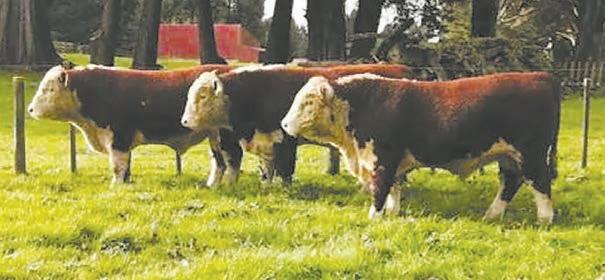
Nor th Canterbur y Thursday 23 May | 1pm - 4pm
Grassmere Hereford & Riverlands Angus, Cheviot, Chris Jeffries, 027 460 8849
Te Mania Angus, Conway Flat, Will Wilding, 027 826 4015
Jandoc Hereford, Hawarden, Doc Sidey, 021 169 9949
Nelson Marlborough Bull Walk Friday 24 May | 9am - 12pm
Leefield Station Angus, Waihopai Valley, Greg Crombie, 027 5511011
Black night Angus, Rai Valley, Ben Maisey, 03 5716271
Taimate Angus, Ward, Paul Hick man, 021 575155
Mar tin Farming Hereford & Angus, Wakefield, Richard Mar tin, 027 2303098
Nelson Marlborough Bull Walk Friday 24 May | 1pm - 4pm
Woodbank Angus, Clarence Bridge, Ben Murray, 027 4494409
Matarik i Herefords, Clarence Bridge, James Murray, 027 4866699
Fur ther Enquiries
John McKone (PGG Wrightson) 027 529 9375
Simon Eddington (PGG Wrightson) 027 590 8612

027 208 3071
 Anthony Cox (Rural Livestock)
Anthony Cox (Rural Livestock)

Proudly sponsored by
There’s usually tight demand on meat processing plants at this point on the calendar as cull cow season runs its course – but that’s not the case this year.
 Alex Coddington MARKETS Sheep and beef
Alex Coddington MARKETS Sheep and beef
THE autumn cull cow offload often stretches from March to May before numbers start to seasonally decline into June. It’s well known that through this period, cattle space at processing plants is usually hard to come by. Especially when you throw in reduced production weeks around Easter and Anzac Day.
But in a strange turn of events, this year there have been very few accounts of space restrictions at processing plants. Which raises the question – where are all the cows?
The cumulative South Island cow kill is down 8.2% compared with last season.
The North is fairly steady, up 3.6%. Season to date (to April 13), the national cow slaughter stands at 437,878 head, only 0.9% less than last year.
The exodus from dairy farming of a lot of smaller players has played a large part in the apparent lack of cows seen at the end of their life cycle. This is most likely a factor in this year’s unusual dynamic in procurement, bucking a few price trends in the saleyard and the schedule.
The AgriHQ procurement indicator for cows usually hits its lowest level around this time of year, before climbing upward into July. This year, our procurement indicator has been stable since mid-April.
Better conditions to keep cows on farm in the North Island’s main dairy regions kept a fair few cattle away from the processors.
The favourable summer growth period left a lot of rough tucker on farm after summer, making this class an attractive option for grazing.
An El Niño autumn has kept cows dry underfoot right through until May. Not to mention the improved conception rates for dairy cows this season and the elevated milk price made it a nobrainer for dairy farmers to keep milking as long as possible.
This has applied some of the extra pressure to keep meat on hooks from a processing perspective, even more so when you consider the favourable export market conditions out of the United States.
The North Island cow slaughter price has held close to $4/kg since February. In the North Island this week, the slaughter price is 20c/ kg above year-ago levels and more than 30c/kg above the five-year average.


The exodus from dairy farming of a lot of smaller players has played a large part in the apparent lack of cows seen at the end of their life cycle.
In the South Island, the cow slaughter price is fairly steady on year-ago levels and only a few cents higher than the five-year average at $3.30/kg.
In the North Island saleyards, the bulk of the cull cow sales are shared between Feilding and
Frankton. Both saleyards sold close to 6900 boner cows in 2023, with numbers increasing slightly this year. Processors have snapped up most of these cows, though grazing interest kept prices competitive.
Prices for cull Friesian cows at Frankton have been consistently higher than year-ago levels for the past 10 weeks.
In April, Friesian cows returned a high of $1.93/kg. At Feilding, prices have also held above yearago levels before easing to $1.85/ kg last week, but this was still 10c/ kg higher than this time last year.
In the South, autumn has
been much harsher for farmers. This week Temuka saleyards hit capacity with more than 1100 cows offered. Most Friesian types made $1.55-$1.65/kg, meeting year-ago levels.
In 2023, more than 13,000 cows were sold at Temuka. To date this year, Temuka has already seen a 12% increase of throughput.
Prices for Friesian cows at Temuka have been almost identical to last year’s price trends, aside from a prolonged elevation above $2/kg through February, when processors were handing out spot premiums to maintain the flow of cows.










Excess dairy cows are getting shifted on in the lead-up to Moving Day. Buyer demand has meant there have been some good returns and most yards recorded another lift this week. At Frankton on Tuesday, the average return for Friesian and Friesian-cross cows was up 12c/kg, to $1.76-$1.82/kg for 480-515kg. On Wednesday, Frankton cows, 515-548kg, fetched $2.00-$2.06/kg. In line with these figures, Friesian at Rangiuru on Tuesday averaged 450kg and $1.86/kg. The same level wasn’t reached at Temuka, where Friesian averaged $1.64/kg, but vendors were pleased that processing space was plentiful considering the full yarding on Monday.


















 Philip Duncan NEWS Weather
Philip Duncan NEWS Weather
FARMERS and growers across New Zealand and Australia have the same problem – where is May’s rain?
The dry weather pattern engulfing both nations is being caused by the same enormous area of high pressure. The main high has been dominating south Australia and much of NZ for the entire first fortnight of May and will likely last well into the third week of the month.
With so much of NZ’s weather coming from this part of the globe it’s worth noting that in the states of Victoria, Tasmania and South Australia, many people are screaming out for rain.
In NZ it’s a bit more subdued because we have had pockets of rain relief over the past month or two, but for some it’s still not enough and with winter almost upon us, time is running out as the nights get colder and longer for at least another month and a half.
Frosts have returned to NZ after being absent on a widespread scale
so far this year. Some regions only had their first frost in the past few days. However, it’s fair to say some of you had a doozy, with minus fives, sixes and even below that.
The frosty weather is also thanks to these powerfully stubborn high pressure zones anchoring themselves around the Tasmania area.
The anticyclonic flow means these highs can have great “reach” over the Southern Ocean area, scooping up much colder air then dredging it up over NZ as a south to southwesterly flow.
NZ has had several warmer than average winters in a row. When I use the word “average”, I’m thinking of the past 40 years or so. In recent years, roughly the past seven, NZ has had much milder winters.
In previous years high pressure was parked further north of NZ and this kept northern NZ in a rainfall deficit for several years, and encouraged plenty of mild westerlies, which dried out the east and kept many places milder.
This year, the high pressure zones are both further south and further over towards Aussie. This encourages more south to

Average Rainfall 9am 22 Apr to 9am 7 May (Based on a 30 year climatology: 1991-2020)
southwest flows from the Southern Ocean area.
In saying that, we might be going into a colder-than-average phase at the moment but compared to 10 to 40 years ago I think most people




Rainfall 9am 22 Apr to 9am 7 May

DRY: Usual rainfall vs current rainfall for this time of year shows New Zealand is leaning much drier in most regions except Southland.
might still consider this milder than usual overall.
The last major snow events into NZ were over a decade ago, in 2011 and 2012. Since then it’s been significantly milder due to the



placement of highs and lows around us. The joy of living on two mountainous large rocks partially in the Roaring Forties – we’re always at the whim of single highs and lows.






